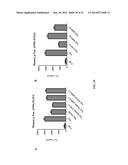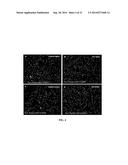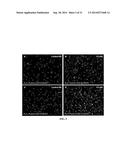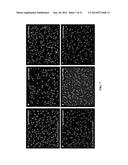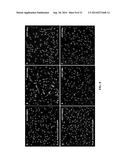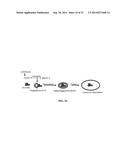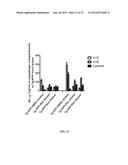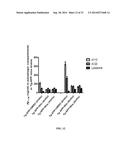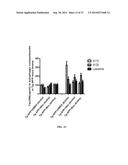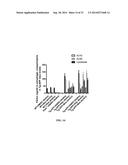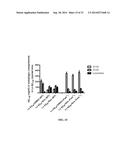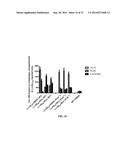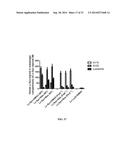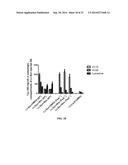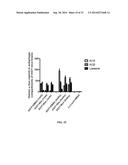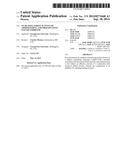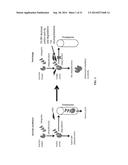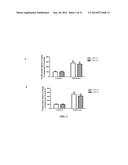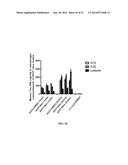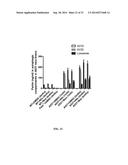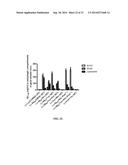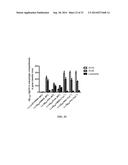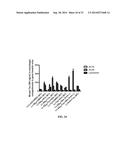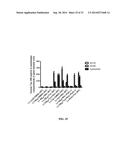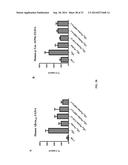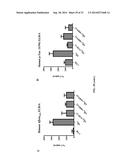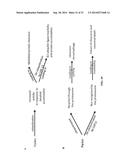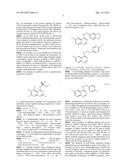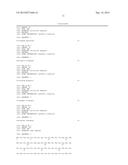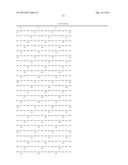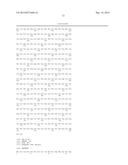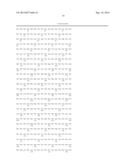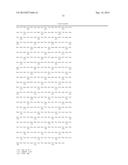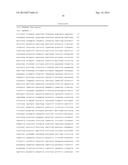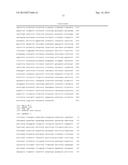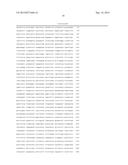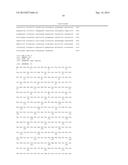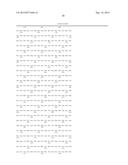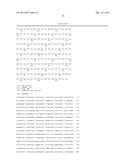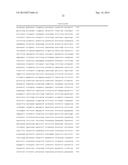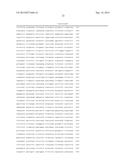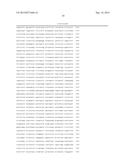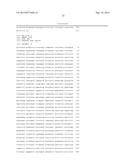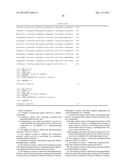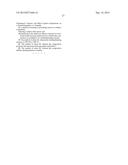Patent application title: INCREASING PARKIN ACTIVITY BY ADMINISTERING A DEUBIQUITINATING ENZYME INHIBITOR
Inventors:
Charbel Moussa (Germantown, MD, US)
Assignees:
GEORGETOWN UNIVERSITY
IPC8 Class: AA61K3800FI
USPC Class:
4241581
Class name: Drug, bio-affecting and body treating compositions immunoglobulin, antiserum, antibody, or antibody fragment, except conjugate or complex of the same with nonimmunoglobulin material binds hormone or other secreted growth regulatory factor, differentiation factor, or intercellular mediator (e.g., cytokine, vascular permeability factor, etc.); or binds serum protein, plasma protein, fibrin, or enzyme
Publication date: 2014-09-18
Patent application number: 20140271668
Abstract:
Provided herein are methods of promoting parkin activity in a subject,
comprising: selecting a subject with a disorder associated with decreased
Parkin activity; and administering to the subject an effective amount of
a composition that increases parkin activity, wherein the composition is
an inhibitor of a deubiquitinating enzyme.Claims:
1. A method of promoting parkin activity in a subject, comprising: a)
selecting a subject with a disorder associated with decreased Parkin
activity; and b) administering to the subject an effective amount of a
composition that increases parkin activity, wherein the composition is an
inhibitor of a deubiquitinating enzyme.
2. The method of claim 1, wherein the deubiquitinating enzyme is USP-10 or USP-13.
3. The method of claim 1, wherein the composition increases parkin activity by promoting the interaction between parkin and beclin-1.
4. The method of claim 1, wherein the composition inhibits deubiquitination of parkin.
5. The method of claim 1, wherein the disorder associated with decreased parkin activity is a neurodegenerative disease, a myodegenerative disease, prion disease or cancer.
6. The method of claim 5, wherein the neurodegenerative disease is selected from the group consisting of Amoytrophic Lateral Sclerosis, Alzheimer's Disease, Parkinson's Disease, Huntington's Disease, and Mild Cognitive Impairment, an α-Synucleinopathy or a Taupathy.
7. A method of treating or preventing a neurodegenerative disease, a myodegenerative disease or prion disease in a subject, comprising: selecting a subject with a neurodegenerative disease of the central nervous system, a myodegenerative disease, a prion disease or at risk for a neurodegenerative disease of the central nervous system, a myodegenerative disease or a prion disease; and administering to the subject an effective amount of a composition that increases parkin activity, wherein the composition is an inhibitor of a deubiquitinating enzyme.
8. The method of claim 7, wherein the deubiquitinating enzyme is USP-10 or USP-13.
9. The method of claim 7, wherein the composition promotes the interaction between parkin and beclin-1.
10. The method of claim 7, wherein the composition inhibits deubiquitination of parkin.
11. The method of claim 7, wherein the neurodegenerative disease is selected from the group consisting of Amoytrophic Lateral Sclerosis, Alzheimer's Disease, Parkinson's Disease, Huntington's Disease, and Mild Cognitive Impairment, an α-Synucleinopathy or a Taupathy.
12. A method of treating or preventing cancer in a subject, comprising: selecting a subject with cancer; and administering to the subject an effective amount of a composition that increases parkin activity, wherein the composition is an inhibitor of a deubiquitinating enzyme.
13. The method of claim 12, wherein the deubiquitinating enzyme is USP-10 or USP-13.
14. The method of claim 12, wherein the composition promotes the interaction between parkin and beclin-1.
15. The method of claim 12, wherein the composition inhibits deubiquitination of parkin.
Description:
[0001] This application claims the benefit of U.S. Application No.
61/794338, filed on Mar. 15, 2013, which is hereby incorporated in its
entirety by this reference.
BACKGROUND
[0003] Neurodegenerative diseases include genetic and sporadic disorders associated with progressive nervous system dysfunction. It has been estimated that one of four Americans will develop a neurodegenerative condition in their lifetimes. Generally, however, the underlying mechanisms causing the conditions are not well understood and few effective treatment options are available for preventing or treating neurodegenerative diseases. Similarly, treatment options for myodegenerative disease and prion disease are also limited.
SUMMARY
[0004] Provided herein is a method of promoting parkin activity in a subject, comprising: selecting a subject with a disorder associated with decreased parkin activity; and administering to the subject an effective amount of a composition that increases parkin activity, wherein the composition is an inhibitor of a deubiquitinating enzyme.
[0005] Further provided is a method of treating or preventing a neurodegenerative disease, a myodegenerative disease or prion disease in a subject, comprising: selecting a subject with a neurodegenerative disease of the central nervous system, a myodegenerative disease, a prion disease or at risk for a neurodegenerative disease of the central nervous system, a myodegenerative disease or a prion disease; and administering to the subject an effective amount of a composition that increases parkin activity, wherein the composition is an inhibitor of a deubiquitinating enzyme.
[0006] Also provided is a method of treating or preventing cancer in a subject, comprising selecting a subject with cancer or at risk for cancer; and administering to the subject an effective amount of a composition that increases parkin activity, wherein the composition is an inhibitor of a deubiquitinating enzyme.
DESCRIPTION OF DRAWINGS
[0007] FIG. 1 is a diagram showing that parkin activity is necessary to clear misfolded proteins via autophagy and the proteasome. Under normal conditions, parkin goes from an inactive to an active state upon ubiquitination. Active parkin facilitates degradation of proteins via autophagy and the proteasome. In certain diseases, for example, a neurodegenerative disease, myodegenerative disease, prion disease or cancer, deubiquitinating enzymes decrease parkin activity, by deubiquitinating parkin, thus decreasing degradation of proteins via autophagy and the proteasome.
[0008] FIG. 2 shows that the level of brain deubiquitinases (USP10 and USP13) is increased in post-mortem human Alzheimer's Disease (AD) (FIG. 2A) and Parkinson's Disease (PD) (FIG. 2B) brains. Densitometry analysis of post-mortem cortex in AD (N=12) and age-matched control subjects (N=7) shows increased levels of USP10 and USP13 in AD cortex compared to control (FIG. 2A). Densitometry analysis of post-mortem caudate in PD (N=9) and age-matched control subjects (N=7) shows A) increased levels of USP10 and USP13 in PD compared to control (FIG. 2B). Mann Whitney, p<0.05. mean±SEM.
[0009] FIG. 3 shows photomicrographs of control (FIGS. 3A, 3C) and post-mortem human AD (FIGS. 3B, 3D) brains, indicating that parkin interaction with deubiquitinase (USP-10) is increased in AD. A Proximity Ligation Assay (PLA) in situ on 30 mm thick human brain sections shows parkin and ubiquitin specific peptidase 10 (USP10). The interaction between parkin and ubiquitin specific peptidase 10 (USP10) is increased in human hippocampus (Figure A and B) and cortex (Figures C and D) in AD. The increase in USP10 level is paralleled by increased interaction with parkin, indicative of parkin deubiquitination and inactivity, which leads to accumulation and decreased solubility in the human brain.
[0010] FIG. 4 shows photomicrographs of control (FIGS. 4A, 4C) and post-mortem human AD (FIGS. 4B, 4D) brains, showing that parkin interaction with deubiquitinase (USP-13) is increased in AD. A Proximity Ligation Assay (PLA) in situ on 30 mm thick human brain sections shows parkin and ubiquitin specific peptidase 10 (USP13). The interaction between parkin and ubiquitin specific peptidase 10 (USP13) is increased in hippocampus (FIGS. 4A, 4C) and cortex (FIGS. 4C and 4D) with AD. The increase in USP13 level is paralleled by increased interaction with parkin, indicative of parkin deubiquitination and inactivity, which leads to accumulation and decreased solubility in the human brain.
[0011] FIG. 5 shows photomicrographs of control (FIGS. 5A, 5C) and post-mortem human PD (FIGS. 5B, 5D) brains showing that parkin interaction with deubiquitinase (USP-10/13) is increased in post-mortem human PD brains. A Proximity Ligation Assay (PLA) in situ on 30 mm thick human brain sections shows parkin and ubiquitin specific peptidase 10/13 (USP10/13). Parkin and ubiquitin specific peptidase 10 (USP10) interaction is increased in human PD midbrain (FIG. 5B) as compared to control (FIG. 5A); and parkin and ubiquitin specific peptidase 13 (USP13) interaction is increased in human PD midbrain (FIG. 5D) as compared to control (FIG. 5C). The increase in USP10/13 level is paralleled by increased interaction with parkin, indicative of parkin de-ubiquitination and inactivity, which leads to accumulation and decreased solubility in the human brain.
[0012] FIG. 6 shows photomicrographs of wild type mouse brain (FIGS. 6A, 6C) and parkin -/- mouse brain (FIGS. 6B, 6D), showing that parkin interacts with deubiquitinating enzymes in wild type but not parkin -/- mice. A Proximity Ligation Assay (PLA) in situ on 20 mm thick brain sections shows parkin and ubiquitin specific peptidase 13 (USP13) interaction in C57BL/6 mice (FIG. 6A) but not parkin-/- mice (FIG. 6B). PLA in situ on 20 mm thick brain sections shows parkin and ubiquitin specific peptidase 10 (USP10) interaction in C57BL/6 (FIG. 6C) mice but not parkin-/- mice (FIG. 6D). These data indicate that parkin could interact with USP10 and 13 under normal conditions.
[0013] FIG. 7 shows photomicrographs of brain sections from Tg-APP mice, indicating that parkin interaction with deubiquitinating enzymes (DUBs) is decreased in Tg-APP mice and tyrosine kinase inhibition increases parkin-DUBs interaction. A Proximity Ligation Assay (PLA) in situ on 20 mm thick brain sections shows parkin and ubiquitin specific peptidase 13 (USP13) in Tg-APP mice treated with DMSO (FIG. 7A), 10 mg/kg Nilotinib (FIG. 7B), and 5 mg/kg Bosutinib (FIG. 7C) daily for 3 weeks. Parkin and ubiquitin specific peptidase 10 (USP10) in Tg-APP mice treated with DMSO (FIG. 7D), 10 mg/kg Nilotinib (FIG. 7E), and 5 mg/kg Bosutinib (FIG. 7F) daily for 3 weeks. Tyrosine kinase inhibition increases the interaction between parkin and USP10 and 13.
[0014] FIG. 8 shows that parkin interaction with deubiquitinating enzymes is decreased in Tg-A53T mice and tyrosine kinase inhibition increases parkin-DUBs interaction. A Proximity Ligation Assay (PLA) in situ on 20 μm thick brain sections shows parkin and ubiquitin specific peptidase 13 (USP13) in A53T mice treated with DMSO (FIG. 8A), 10 mg/kg Nilotinib (FIG. 8B), and 5 mg/kg Bosutinib (FIG. 8C) daily for 3 weeks. Parkin and ubiquitin specific peptidase 10 (USP10) in A53T mice treated with DMSO (FIG. 8D), 10 mg/kg Nilotinib (FIG. 8E), and 5 mg/kg Bosutinib (FIG. 8F) daily for 3 weeks. Tyrosine kinase inhibition increases the interaction between parkin and USP10 and 13.
[0015] FIG. 9 shows in situ proximity ligation assay (PLA) showing endogenous parkin-beclin-1 complexes in WT C57BL/6 mice (FIG. 9A) (N=5) and parkin-/-mice (FIG. 9B). Also shown is PLA in Tg-APP mice IP injected once daily for 3 weeks with DMSO (FIG. 9C) 5 mg/kg Bosutinib (FIG. 9D) and 10 mg/kg Nilotinib (FIG. 9E) (N=5). Further shown is PLA in human post-mortem brains in the cortex of a normal subject (FIG. 9F) and cortex of an AD patient (FIG. 9G); the hippocampus of a normal subject (FIG. 9H) and of an AD patient (FIG. 9I); the caudate of a normal subject (FIG. 9J) and of an AD/PD patient (FIG. 9K). The increased parkin-USP10/13 interaction is paralleled by decreased parkin-beclin-1 interaction, indicating that DUB deubiquitination of parkin decreases functional parkin-beclin-1 interaction. This data shows that parkin interaction with DUBs, such as ubiquitin specific proteases (USP)-13 and USP-10 regulate parkin activity via deubiquitination.
[0016] FIG. 10 is a schematic showing that amyloid accumulation leads to autophagic induction and sequestration in phagophores. In transgenic or amyloid expressing animals parkin interaction with beclin-1 is reduced, leading to decreased maturation of phagophore into autophagosomes and autophagic defects. Kinase inhibition activates parkin and increases its interaction with beclin-1, resulting in maturation of phagophores into phagosomes and clearance. Also in human AD and PD brains parkin-beclin-1 interaction is reduced, indicating that USPs inactivate parkin and prevent functional interaction with beclin-1 to execute autophagic clearance of misfolded amyloid proteins.
[0017] FIG. 11 is a bar graph showing that Aβ1-42 accumulates in AV-10 in Tg-APP animals but drug treatment enhances autophagic clearance via deposition of Aβ1-42 in AV-20 and lysosome. Bars show Aβ1-42 in subcellular fractions, including autophagic vacuole-10 (AV-10; phagophores+autophagosomes), AV-20 (autophagosomes) and lysosomes. Transgenic 3× APP mice were injected IP with 10 mg/kg Nilotinib or 5 mg/Kg Bosutinib or DMSO once a day for 3 consecutive weeks. Brain tissues were fractionated to isolate AVs and human specific ELISA was performed to determine protein contents. N=5 animals per treatment.
[0018] FIG. 12 is a bar graph showing that Aβ1-40 accumulates in AV-20 in Tg-APP animals but drug treatment enhances autophagic clearance via deposition of Aβ1-40 in AV-20 and lysosome. Histograms show Aβ1-40 in subcellular fractions, including autophagic vacuole-10 (AV-10; phagophores+autophagosomes), AV-20 (autophagosomes) and lysosomes. Transgenic 3× APP mice were injected IP with 10 mg/kg Nilotinib or 5 mg/Kg Bosutinib or DMSO once a day for 3 consecutive weeks. Brain tissues were fractionated to isolate AVs and specific ELISA was performed to determine protein contents. N=5 animals per treatment.
[0019] FIG. 13 is a bar graph showing that P-Tau accumulates in AV-10 in Tg-APP animals but drug treatment enhances autophagic clearance via deposition of p-Tau in AV-20 and lysosome, which contains degradative enzymes. Histograms show Tau hyper-phosphorylation (p-Tau) at serine 396 in subcellular fractions, including autophagic vacuole-10 (AV-10; phagophores+autophagosomes), AV-20 (autophagosomes) and lysosomes. Transgenic 3× APP mice were injected IP with 10 mg/kg Nilotinib or 5 mg/Kg Bosutinib or DMSO once a day for 3 consecutive weeks. Brain tissues were fractionated to isolate AVs and mouse-specific ELISA was performed to determine protein contents. N=5 animals per treatment.
[0020] FIG. 14 is a bar graph showing that drug treatment increases parkin activity leading to protein clearance including parkin itself. Histograms show parkin in subcellular fractions, including autophagic vacuole-10 (AV-10; phagophores+autophagosomes), AV-20 (autophagosomes) and lysosomes. Transgenic 3× APP mice were injected IP with 10 mg/kg Nilotinib or 5 mg/kg Bosutinib or DMSO once a day for 3 consecutive weeks. Brain tissues were fractionated to isolate AVs and mouse specific ELISA was performed to determine protein contents. parkin accumulates in AV-10 in Tg-APP animals but drug treatment enhances autophagic clearance via deposition of parkin in AV-20 and lysosome, which contains degradative enzymes. N=5 animals per treatment.
[0021] FIG. 15 is a bar graph showing that autophagic clearance is parkin-dependent. Histograms show Aβ1-42 in subcellular fractions, including autophagic vacuole-10 (AV-10; phagophores+autophagosomes), AV-20 (autophagosomes) and lysosomes. Wild type or parkin-/- mice injected with lentiviral Aβ1-42 for 3 weeks and treated IP with 10 mg/kg Nilotinib or 5 mg/Kg Bosutinib or DMSO once a day for 3 (additional) consecutive weeks. Brain tissues were fractionated to isolate AVs and human specific ELISA was performed to determine protein contents. Aβ1-42 accumulates in AV-10 in lentivirus injected brains but drug treatment enhances autophagic clearance via deposition of Aβ1-42 in AV-20 and lysosome. N=5 animals per treatment.
[0022] FIG. 16 is a bar graph showing that P-Tau at serine 396 accumulates in AV-10 in lentivirus injected brains but drug treatment enhances autophagic clearance via deposition of p-Tau in AV-20 and lysosome, where it is degraded. Histograms show p-Tau in subcellular fractions, including autophagic vacuole-10 (AV-10; phagophores+autophagosomes), AV-20 (autophagosomes) and lysosomes. Wild type or parkin-/- mice injected with lentiviral Aβ1-42 for 3 weeks and treated IP with 10 mg/kg Nilotinib or 5 mg/Kg Bosutinib or DMSO once a day for 3 (additional) consecutive weeks. Brain tissues were fractionated to isolate AVs and mouse specific. ELISA was performed to determine protein contents. Autophagic clearance is parkin-dependent. N=5 animals per treatment.
[0023] FIG. 17 is a bar graph showing that α-synuclein accumulates in AV-10 in lentivirus injected brains but drug treatment enhances autophagic clearance via deposition of α-synuclein in AV-20 and lysosome, which contains degradative enzymes. Histograms show α-synuclein in subcellular fractions, including autophagic vacuole-10 (AV-10; phagophores+autophagosomes), AV-20 (autophagosomes) and lysosomes. Wild type or parkin-/- mice injected SN with lentiviral α-synuclein for 3 weeks and treated IP with 10 mg/kg Nilotinib or 5 mg/Kg Bosutinib or DMSO once a day for 3 (additional) consecutive weeks. SN tissues were fractionated to isolate AVs and human specific ELISA was performed to determine protein contents. Autophagic cleareance is parkin-dependent. N=5 animals per treatment.
[0024] FIG. 18 is a bar graph showing that P-Tau accumulates in AV-10 in lentivirus injected brains but drug treatment enhances autophagic clearance via p-Tau deposition in AV-20 and lysosome, which contains degradative enzymes. Histograms show p-Tau at serine 396 in subcellular fractions, including autophagic vacuole-10 (AV-10; phagophores+autophagosomes), AV-20 (autophagosomes) and lysosomes. Wild type or parkin-/- mice injected SN with lentiviral α-synuclein for 3 weeks and treated IP with 10 mg/kg Nilotinib or 5 mg/Kg Bosutinib or DMSO once a day for 3 (additional) consecutive weeks. SN tissues were fractionated to isolate AVs and mouse specific ELISA was performed to determine protein contents. Autophagic clearance is parkin-dependent. N=5 animals per treatment.
[0025] FIG. 19 is a bar graph showing that α-synuclein accumulates in AV-10 in A53T brains but drug treatment enhances autophagic clearance via α-synuclein deposition in AV-20 and lysosome. Bars show α-synuclein in subcellular fractions, including autophagic vacuole-10 (AV-10; phagophores+autophagosomes), AV-20 (autophagosomes) and lysosomes, containing digestive enzymes. Transgenic A53T mice were injected IP with 10 mg/kg Nilotinib or 5 mg/Kg Bosutinib or DMSO once a day for 3 consecutive weeks. Brain tissues were fractionated to isolate AVs and human specific ELISA was performed to determine protein contents. N=5 animals per treatment.
[0026] FIG. 20 is a bar graph showing that P-Tau accumulates in AV-10 in A53T brains but drug treatment enhances autophagic clearance via p-tau deposition in AV-20 and lysosome. Histograms show p-Tau at Serine 396 in subcellular fractions, including autophagic vacuole-10 (AV-10; phagophores+autophagosomes), AV-20 (autophagosomes) and lysosomes, containing digestive enzymes. Transgenic A53T mice were injected IP with 10 mg/kg Nilotinib or 5 mg/Kg Bosutinib or DMSO once a day for 3 consecutive weeks. Brain tissues were fractionated to isolate AVs and mouse specific ELISA was performed to determine protein contents. N=5 animals per treatment.
[0027] FIG. 21 is a bar graph showing that parkin accumulates in AV-10 in A53T brains but drug treatment enhances autophagic clearance via parkin deposition in AV-20 and lysosome. Bars show parkin in subcellular fractions, including autophagic vacuole-10 (AV-10; phagophores+autophagosomes), AV-20 (autophagosomes) and lysosomes, containing digestive enzymes. Transgenic A53T mice were injected IP with 10 mg/kg Nilotinib or 5 mg/Kg Bosutinib or DMSO once a day for 3 consecutive weeks. Brain tissues were fractionated to isolate AVs and mouse specific ELISA was performed to determine protein contents. N=5 animals per treatment.
[0028] FIG. 22 is a bar graph showing that Tau expression leads to Aβ1-42 accumulation in AV10 and AV20, but not in lysosomes, indicating decreased fusion between autophagosomes and lysosomes. Bars show Aβ1-42 in subcellular fractions, including autophagic vacuole-10 (AV-10; phagophores+autophagosomes), AV-20 (autophagosomes) and lysosomes. Wild type or parkin-/- mice injected with lentiviral Tau±Aβ1-42 for 3 weeks and treated IP with 10 mg/kg Nilotinib or DMSO once a day for 3 (additional) consecutive weeks. Brain tissues were fractionated to isolate AVs and human specific ELISA was performed to determine Aβ1-42 contents. Aβ1-42 accumulates in AV-10 in lentivirus injected brains but drug treatment enhances autophagic clearance via deposition of Aβ1-42 in AV-20 and lysosome. Autophagic clearance is parkin-dependent. N=5 animals per treatment.
[0029] FIG. 23 is a bar graph showing that Aβ1-42 accumulates in AV-10 in lentivirus injected brains but drug treatment enhances autophagic clearance via deposition of Aβ1-42 in AV-20 and lysosome. Autophagic clearance is less efficient in Tau null animals with Aβ1-42 accumulation in AV-10 and AV-20. Bars show Aβ1-42 in subcellular fractions, including autophagic vacuole-10 (AV-10; phagophores+autophagosomes), AV-20 (autophagosomes) and lysosomes. Wild type or Tau-/- mice injected with lentiviral Aβ1-42 for 3 weeks and treated IP with 10 mg/kg Nilotinib or 5 mg/Kg Bosutinib or DMSO once a day for 3 (additional) consecutive weeks. Brain tissues were fractionated to isolate AVs and human specific ELISA was performed to determine protein contents. N=5 animals per treatment.
[0030] FIG. 24 is a bar graph showing that P-Tau at serine 396 accumulates in AV-10 in lentivirus injected brains but drug treatment enhances autophagic clearance via deposition of p-Tau in AV-20 and lysosome, where it is degraded. Bars show p-Tau in subcellular fractions, including autophagic vacuole-10 (AV-10; phagophores+autophagosomes), AV-20 (autophagosomes) and lysosomes. Wild type or parkin-/- mice injected with lentiviral human Tau±Aβ1-42 for 3 weeks and treated IP with 10 mg/kg Nilotinib or 30 μL DMSO once a day for 3 (additional) consecutive weeks. Brain tissues were fractionated to isolate AVs and mouse specific ELISA was performed to determine protein contents. Autophagic clearance is parkin-dependent. N=5 animals per treatment.
[0031] FIG. 25 is a bar graph showing that P-Tau at serine 396 accumulates in AV-10 in lentivirus injected brains but drug treatment enhances autophagic clearance via deposition of p-Tau in AV-20 and lysosome, where it is degraded. Histograms show p-Tau in subcellular fractions, including autophagic vacuole-10 (AV-10; phagophores+autophagosomes), AV-20 (autophagosomes) and lysosomes. Wild type or parkin-/- mice injected with lentiviral Tau±Aβ1-42 for 3 weeks and treated IP with 10 mg/kg Nilotinib or 5 mg/Kg Bosutinib or DMSO once a day for 3 (additional) consecutive weeks. Brain tissues were fractionated to isolate AVs and human specific ELISA was performed to determine protein contents. Autophagic clearance is parkin-dependent. N=5 animals per treatment.
[0032] FIG. 26 is a Western blot analysis of sodium Tris EDTA NP40 (STEN) (soluble) extracts of human M17 cells. Lentiviral USP13 expression (FIG. 26A) (1st blot), endogenous USP10 levels (FIG. 26A) (2nd blot), and lentiviral parkin expression (FIG. 26A) (3rd blot) relative to actin (FIG. 26A) (4th blot) on 10% NuPAGE SDS gel are shown. FIG. 26B shows densitometry results. Western blot analysis of 4 M urea (insoluble) extracts showing parkin levels (FIG. 26C) (1st blot) relative to actin on 10% NuPAGE SDS gel are provided with densitometry results (FIG. 26D). FIG. 26E is a Western blot showing immunoprecipitated (IP) parkin from human M17 cells overexpressing parkin ±USP13 and probed with ubiquitin (1st blot), USP13 (2nd blot) and parkin (3rd blot) relative to actin and input. The graph in FIG. 26F represents parkin activity in human M17 cells as measured by ELISA in the presence of E1-E2 and ATP. N=7 for every treatment; * indicates significantly different, ANOVA, Neuman Keuls multiple comparison, P<0.05.
[0033] FIG. 27 is a Western blot analysis of STEN (soluble) extracts of M17 cells. FIG. 27A shows lentiviral USP13 expression (1st blot) and USP13 shRNA named (E08, E07, F04, F03 and F02), endogenous USP10 levels (2nd blot), and parkin expression (3rd blot) relative to actin (4th blot) on a 10% NuPAGE SDS gel. FIG. 27B is a graph representing chymotrypsin-like 26S proteasome activity with lentiviral parkin, USP13 or shRNA. N=4 for every treatment; *indicates significantly different, ANOVA, Neuman Keuls multiple comparison, P<0.05.
[0034] FIG. 28 shows that USP13 deletion increases parkin-mediated amyloid clearance. Human M17 cells were transfected with USP13 cDNAs and shRNAs in the presence of αβ42. ELISA was performed showing the level of αβ42 and hyperphosphorylated Tau at Ser 396 in the presence of parkin (FIGS. 28A and B) and in the absence of parkin (FIGS. 28C and D) absence of parkin.
[0035] FIG. 29 shows that USP13 deletion can increase parkin-mediated Tau clearance. Human M17 cells were transfected with USP13 cDNAs and shRNAs in the presence of Tau and ELISA was performed showing the level of hyper-phosphorylated Tau at Ser 396 in the presence of parkin (FIG. 29A) and in the absence of parkin (FIG. 29B).
[0036] FIG. 30 shows that ubiquitinated parkin is activated in response to amyloid (alpha-Synuclein, beta-amyloid, Tau and TDP-43) accumulation, leading to facilitation of clearance. An increase in USP13 leads to parkin deubiquitination and decreased activity, resulting in misfolded protein accumulation in neurodegenerative diseases (FIG. 30A). It is likely that ubiquitination activates parkin, which is then recycled through the proteasome to prevent its accumulation (FIG. 30B). Activated parkin facilitates autophagic clearance. An increase in USP13 leads to parkin deubiquitination and decreased proteasomal recognition, leading to its instability/insolubility and accumulation. This results in subsequent autophagic failure and death of neurons (FIG. 30B).
DETAILED DESCRIPTION
[0037] Provided herein is a method of promoting parkin activity in a subject, comprising selecting a subject with a disorder associated with decreased Parkin activity and administering to the subject an effective amount of a composition that increases parkin activity, wherein the composition is an inhibitor of a deubiquitinating enzyme. A disorder associated with decreased parkin activity can be, but is not limited to, a neurodegenerative disease, a myodegenerative disease, prion disease or cancer. In the methods provided herein, neurodegenerative diseases of the central nervous system include, but are not limited to, Amyotrophic Lateral Sclerosis, Alzheimer's Disease, Parkinson's Disease, frontotemporal dementia, Huntington's Disease, Mild Cognitive Impairment, an α-Synucleinopathy, a Tauopathy or a pathology associated with intracellular accumulation of TDP-43.
[0038] In the methods provided herein, myodegenerative diseases include, but are not limited to, inclusion body myositis (IBM), spinal-bulbar muscular atrophy (SBMA), and motor neuron disease (MND). In the methods provided herein, prion diseases or transmissible spongiform encephalopathies (TSEs) include, but are not limited to, Creutzfeldt-Jakob Disease (CJD), Variant Creutzfeldt-Jakob Disease (vCJD), Gerstmann-Straussler-Scheinker Syndrome, Fatal Familial Insomnia and Kuru in humans. Animal prion diseases include, but are not limited to, Scrapie, Bovine Spongiform Encephalopathy (BSE), Chronic Wasting Disease (CWD), Transmissible mink encephalopathy, Feline spongiform encephalopathy and Ungulate spongiform encephalopathy.
[0039] As used throughout, cancer refers to any cellular disorder in which the cells proliferate more rapidly than normal tissue growth. A proliferative disorder includes, but is not limited to, neoplasms, which are also referred to as tumors. A neoplasm can include, but is not limited to, pancreatic cancer, breast cancer, brain cancer (e.g., glioblastoma), lung cancer, prostate cancer, colorectal cancer, thyroid cancer, renal cancer, adrenal cancer, liver cancer, neurofibromatosis 1, and leukemia. A neoplasm can be a solid neoplasm (e.g., sarcoma or carcinoma) or a cancerous growth affecting the hematopoietic system (e.g., lymphoma or leukemia). Other proliferative disorders include, but are not limited to neurofibromatosis.
[0040] One of skill in the art would know how to select a subject with a disorder associated with decreased parkin activity. For example, and not to be limiting, one of skill in the art knows how to diagnose a subject with or at risk of developing a neurodegenerative disease. For example, one or more of the follow tests can be used genetic test (e.g., identification of a mutation in TDP-43 gene) or familial analysis (e.g., family history), central nervous system imaging (e.g., magnetic resonance imaging and positron emission tomography), clinical or behavioral tests (e.g., assessments of muscle weakness, tremor, or memory), laboratory tests.
[0041] One of skill in the art would also know how to identify a subject with decreased parkin activity. Methods for measuring parkin activity are known in the art. See, for example, Schlossmacher and Shimura ("Parkinson's disease: assays for the ubiquitin ligase activity of neural Parkin," Methods Mol. Biol. 301: 351-69 (2005)); Morrison et al. ("A simple cell based assay to measure Parkin activity," J. Neurochem. 116(3): 342-9 (2011)) and Burns et al. (Hum. Mol. Genet. 18 3206-3216 (2009)).
[0042] One or more inhibitors of deubiquitinating enzymes (DUBs) can be used to increase parkin activity. Deubiquitinizing enzymes include, but are not limited to, ubiquitin carboxyl-terminal hydrolase 10 (USP10) and ubiquitin carboxyl-terminal hydrolase 13 (USP13). USP10 and USP13 are enzymes that specifically cleave ubiquitin from ubiquitin-conjugated protein substrates. Protein sequences for USP10 are provided herein as SEQ ID NO: 6 and SEQ ID NO: 7. SEQ ID NO: 6 corresponds to the protein sequence for isoform 1 of human USP10, which can be found under GenBank Accession No. NP--001259004.1. SEQ ID NO: 7 corresponds to the protein sequence for isoform 2 of human USP10, which can be found under GenBank Accession No. NP--005144.2. Nucleic acid sequences encoding USP 10 isoform 1 and USP 10 isoform 2 are provided herein as SEQ ID NO: 8 (GenBank Accession No. NM--001272075.1) and SEQ ID NO: 9 (GenBank Accession No. NM--005153.2), respectively. SEQ ID NO: 10 corresponds to the protein sequence for human USP13 found under GenBank Accession No. NP--003931.2. Nucleic acid sequences encoding USP13 are provided herein as SEQ ID NO: 11 (GenBank Accession No. NM--003940.2) and SEQ ID NO: 12. The coding sequence for USP13 can comprise nucleic acids 82-2673 of SEQ ID NO: 11.
[0043] As set forth above, DUBs, such as USP10 and USP13, deubiquitinate parkin, thus reducing parkin activity. Upon reduction of parkin activity, the interaction between parkin and beclin-1 is also reduced. Therefore, inhibition of DUBs prevents deubiquitination of parkin, which leads to increased parkin activity and an increase in the interaction between parkin and beclin-1. Optionally, these inhibitors can cross the blood brain barrier.
[0044] For example, one or more inhibitors of USP10 and/or USP13 can be used in the methods set forth herein. An inhibitor can be a chemical, a small or large molecule (organic or inorganic), a drug, a protein, a peptide, a cDNA, an antibody, a morpholino, a triple helix molecule, an siRNA, a shRNA, an miRNA, an antisense RNA, a ribozyme or any other compound now known or identified in the future that inhibits at least one activity of USP10 and/or USP13, for example, deubiquitination of parkin.
[0045] For example, the inhibitor can be a compound represented by formula I:
##STR00001##
or a pharmaceutically acceptable salt, biologically active metabolite, solvate, hydrate, prodrug, enantiomer or stereoisomer thereof, wherein
[0046] n is 0, 1, 2, 3 or 4;
[0047] Y is --C(R1)═ or --N═; R is --H, lower alkyl, --CH3, lower fluoroalkyl, --CH2F, --CHF2, --CF3, --NO2, --OH, --NH2, NH(lower alkyl), --N(lower alkyl)2, or lower alkynyl;
[0048] R1 is independently selected for each occurrence from the group consisting of --H, --F, --Cl, --Br, --I, --NO2, --OH, --NH2, --NH(lower alkyl), --N(lower alkyl)2, --CH3, --CF3, --C(═O)(lower alkyl), --CN, --O(lower alkyl), --O(lower fluoroalkyl), --S(═O)(lower alkyl), --S(═O)2lower alkyl) and C(═O)O(lower alkyl);
[0049] R2 and R3 are independently selected from the group consisting of --H, lower alkyl, lower fluoroalkyl, lower alkynyl and hydroxyalkyl;
[0050] X is --O--, --S--, --N(H)--, --N(lower alkyl)-, --CH2--, --CH2CH2--, --CH2CH2CH2--, --CH2CH2CH2CH2--, --CH2CH2CH2CH2CH2-- or --CH2CH2CH2CH2CH2CH2--; and
[0051] Z is phenyl, pyridyl, vinyl, morphinyl, phenanthrolinyl, naphthyl, furyl or benzo[d]thiazolyl; and optionally substituted with one or more substitutents selected from the group consisting of --CH3, lower alkyl, fluoroalkyl, --OCH3, --OCF3, lower fluoroalkoxy, --F, --Cl, --Br, --I, --NO2, lower alkyoxy, --NH(lower alkyl), --N(lower alkyl)2, --CF3, and 3,4-methylene dioxy. Optionally, the compound of formula I is not
##STR00002##
wherein J is Cl, OCHF2, OCH2CH3, OCH2CF3, O(CH2)2CH3, OCH(CH3)2, O(CH2)3CH3, or O(cyclopentyl).
[0052] A non-limiting example of Formula 1 that can be used in the method set forth herein is spautin-1, or a derivative thereof. Pharmaceutical salts of spautin-1 and its derivatives are also provided herein.
##STR00003##
[0053] Identification of additional inhibitors can be determined using methods known in the art. See, for example, Lee et al. "A High-Throughput Screening Method for Identification of Inhibitors of the Deubiquitinating Enzyme USP14," Curr. Protoc. Chem. Biol. 4: 311-330 (2012); Tian et al. "Characterization of selective ubiquitin and ubiquitin-like protease inhibitors using a fluorescence-based multiplex assay format," Assay Drug Dev. Technol. 9(2): 165-173 (2011), both of which are incorporated herein in their entireties by this reference.
[0054] Other examples of inhibitors include, but are not limited to, shRNA sequences that inhibit USP13, such as, SEQ ID NOs: 1-4, set forth in the Examples. Additional examples of shRNA sequence that can be used to inhibit USP13 include, but are not limited to, SEQ ID NO: 13 (5'AAATCGTCATCAGTATCTA3') and SEQ ID NO: 14 (5'CCATGTGAACAATGATCCA3'). Other antisense, siRNA or shRNA sequences can be readily obtained by one of skill in the art based on the known coding sequences of USP10 and USP13 provided herein.
[0055] The methods set forth herein optionally include administering a second therapeutic agent to the subject. For example, in order to treat a neurodegenerative disorder, the second therapeutic agent can be selected from the group consisting of levadopa, a dopamine agonist, an anticholinergic agent, a monoamine oxidase inhibitor, a COMT inhibitor, amantadine, rivastigmine, an NMDA antagonist, a cholinesterase inhibitor, riluzole, an anti-psychotic agent, an antidepressant, and tetrabenazine. In another example, in order to treat cancer, the second therapeutic agent, can be, for example, a chemotherapeutic agent or radiation.
[0056] As used throughout, an increase in parkin activity, and/or an increase in the interaction between parkin and beclin-1 in a subject can be an increase of about 10% , 20%, 30%, 40%, 50%, 60%, 70%, 80% 90%, 100% or greater as compared to a control. For example, the increase in parkin activity and/or the increase in the interaction between parkin and beclin-1 can be an increase of about 10%, 20%, 30%, 40%, 50%, 60%, 70%, 80% 90%, 100% or greater as compared to a subject that was not administered a deubiquitinating enzyme inhibitor or a control value.
[0057] The amount of inhibition or reduction of activity of the deubiquitinating enzyme does not have to be complete as this can range from a decrease to complete ablation of enzymatic activity. For example, the reduction can be about a 10, 20, 30, 40, 50, 60, 70, 80, 90, 100%, or any amount of reduction in between Inhibition or reduction of activity of the deubiquitinating enzyme can be due to a decrease in mRNA expression, a decrease in protein expression, and/or a decrease in the enzymatic activity of the deubiquitinating enzyme.
[0058] Further provided is a method of treating or preventing a neurodegenerative disease, a myodegenerative disease or prion disease in a subject, comprising: selecting a subject with a neurodegenerative disease of the central nervous system, a myodegenerative disease, a prion disease or at risk for a neurodegenerative disease of the central nervous system, a myodegenerative disease or a prion disease; and administering to the subject an effective amount of a composition that increases parkin activity, wherein the composition is an inhibitor of a deubiquitinating enzyme.
[0059] Also provided is a method of treating or preventing cancer in a subject, comprising: selecting a subject cancer or at risk for cancer; and administering to the subject an effective amount of a composition that increases parkin activity, wherein the composition is an inhibitor of a deubiquitinating enzyme.
[0060] The deubiquitinating enzyme inhibitors can be in a pharmaceutically acceptable carrier. The term carrier means a compound, composition, substance, or structure that, when in combination with a compound or composition, aids or facilitates preparation, storage, administration, delivery, effectiveness, selectivity, or any other feature of the compound or composition for its intended use or purpose. For example, a carrier can be selected to minimize any degradation of the active ingredient and to minimize any adverse side effects in the subject. Such pharmaceutically acceptable carriers include sterile biocompatible pharmaceutical carriers, including, but not limited to, saline, buffered saline, artificial cerebral spinal fluid, dextrose, and water.
[0061] Modes of administration of the compositions used in the invention are exemplified below. Any of the inhibitors described herein can be delivered by any of a variety of routes including: by injection (e.g., subcutaneous, intramuscular, intravenous, intra-arterial, intraperitoneal), by continuous intravenous infusion, cutaneously, dermally, transdermally, orally (e.g., tablet, pill, liquid medicine, edible film strip), by implanted osmotic pumps, by suppository, or by aerosol spray. Routes of administration include, but are not limited to, topical, intradermal, intrathecal, intralesional, intratumoral, intrabladder, intravaginal, intra-ocular, intrarectal, intrapulmonary, intracranial, intraventricular, intraspinal, dermal, subdermal, intra-articular, placement within cavities of the body, nasal inhalation, pulmonary inhalation, impression into skin, and electroporation.
[0062] In an example in which a nucleic acid is employed, such as an antisense, shRNA, or siRNA molecule, the nucleic acid can be delivered intracellularly (for example by expression from a nucleic acid vector or by receptor-mediated mechanisms), or by an appropriate nucleic acid expression vector which is administered so that it becomes intracellular, for example by use of a retroviral vector (see U.S. Pat. No. 4,980,286), or by direct injection, or by use of microparticle bombardment (such as a gene gun; Biolistic, Dupont), or coating with lipids or cell-surface receptors or transfecting agents, or by administering it in linkage to a homeobox-like peptide which is known to enter the nucleus (for example Joliot et al., Proc. Natl. Acad. Sci. USA 1991, 88:1864-8). Antisense or siRNA carriers also include, polyethylene glycol (PEG), PEG-liposomes, branched carriers composed of histidine and lysine (HK polymers), chitosan-thiamine pyrophosphate carriers, surfactants, nanochitosan carriers, and D5W solution. The present disclosure includes all forms of nucleic acid delivery, including synthetic oligos, naked DNA, plasmid and viral delivery, integrated into the genome or not.
[0063] As mentioned above, vector delivery can be via a viral system, such as a retroviral vector system which can package a recombinant retroviral genome (see e.g., Pastan et al., Proc. Natl. Acad. Sci. U.S.A. 85:4486, 1988; Miller et al., Mol. Cell. Biol. 6:2895, 1986). The exact method of introducing the altered nucleic acid into mammalian cells is, of course, not limited to the use of retroviral vectors. Other techniques are widely available for this procedure including the use of adenoviral vectors (Mitani et al., Hum. Gene Ther. 5:941-948, 1994), adeno-associated viral (AAV) vectors (Goodman et al., Blood 84:1492-1500, 1994), lentiviral vectors (Naidini et al., Science 272:263-267, 1996), and pseudotyped retroviral vectors (Agrawal et al., Exper. Hematol. 24:738-747, 1996). It is also possible to deliver short hairpin RNAs (shRNAs) via vector delivery systems in order to inhibit gene expression (See Pichler et al. "In vivo RNA interference-mediated ablation of MDR1 P-glycoprotein." Clin Cancer Res. Jun. 15, 2005; 11(12):4487-94; Lee et al. "Specific inhibition of HIV-1 replication by short hairpin RNAs targeting human cyclin T1 without inducing apoptosis." FEBS Lett. Jun. 6, 2005; 579(14):3100-6.).
[0064] Physical transduction techniques can also be used, such as liposome delivery and receptor-mediated and other endocytosis mechanisms (see, for example, Schwartzenberger et al., Blood 87:472-478, 1996) to name a few examples. This invention can be used in conjunction with any of these or other commonly used gene transfer methods.
[0065] The effective amount of an inhibitor can depend on the nature of the disease and can be determined by standard clinical techniques. Therefore, these amounts will vary. For example, the dosage can be anywhere from 0.01 mg/kg to 100 mg/kg. Multiple dosages can also be administered depending on the disease, and the subject's condition. In addition, in vitro assays can be employed to identify optimal dosage ranges. The precise dose to be employed in the formulation will also depend on the route of administration, and the seriousness of the disease or disorder, and should be decided according to the judgment of the practitioner and each subject's circumstances. Effective doses can be extrapolated from dose-response curves derived from in vitro or animal model test systems.
[0066] The disclosure also provides a pharmaceutical pack or kit comprising one or more containers filled with one or more of the ingredients of the pharmaceutical compositions. Optionally associated with such container(s) can be a notice in the form prescribed by a governmental agency regulating the manufacture, use or sale of pharmaceuticals or biological products, which notice reflects approval by the agency of manufacture, use or sale for human administration. Instructions for use of the composition can also be included.
[0067] Depending on the intended mode of administration, the pharmaceutical composition can be in the form of solid, semi-solid, or liquid dosage forms, such as, for example, tablets, suppositories, pills, capsules, powders, liquids, aerosols, or suspensions, preferably in unit dosage form suitable for single administration of a precise dosage. The compositions will include a therapeutically effective amount of the compound described herein or derivatives thereof in combination with a pharmaceutically acceptable carrier and, in addition, can include other medicinal agents, pharmaceutical agents, carriers, or diluents. By pharmaceutically acceptable is meant a material that is not biologically or otherwise undesirable, which can be administered to an individual along with the selected compound without causing unacceptable biological effects or interacting in a deleterious manner with the other components of the pharmaceutical composition in which it is contained.
[0068] As used herein, the term carrier encompasses any excipient, diluent, filler, salt, buffer, stabilizer, solubilizer, lipid, or other material well known in the art for use in pharmaceutical formulations. The choice of a carrier for use in a composition will depend upon the intended route of administration for the composition. The preparation of pharmaceutically acceptable carriers and formulations containing these materials is described in, e.g., Remington's Pharmaceutical Sciences, 21st Edition, ed. University of the Sciences in Philadelphia, Lippincott, Williams & Wilkins, Philadelphia Pa., 2005. Examples of physiologically acceptable carriers include buffers such as phosphate buffers, citrate buffer, and buffers with other organic acids; antioxidants including ascorbic acid; low molecular weight (less than about 10 residues) polypeptides; proteins, such as serum albumin, gelatin, or immunoglobulins; hydrophilic polymers such as polyvinylpyrrolidone; amino acids such as glycine, glutamine, asparagine, arginine or lysine; monosaccharides, disaccharides, and other carbohydrates including glucose, mannose, or dextrins; chelating agents such as EDTA; sugar alcohols such as mannitol or sorbitol; salt-forming counterions such as sodium; and/or nonionic surfactants such as TWEEN® (ICI, Inc.; Bridgewater, N.J.), polyethylene glycol (PEG), and PLURONICS® (BASF; Florham Park, N.J.).
[0069] Compositions containing one or more of the compounds described herein or pharmaceutically acceptable salts or prodrugs thereof suitable for parenteral injection can comprise physiologically acceptable sterile aqueous or nonaqueous solutions, dispersions, suspensions or emulsions, and sterile powders for reconstitution into sterile injectable solutions or dispersions. Examples of suitable aqueous and nonaqueous carriers, diluents, solvents or vehicles include water, ethanol, polyols (propyleneglycol, polyethyleneglycol, glycerol, and the like), suitable mixtures thereof, vegetable oils (such as olive oil) and injectable organic esters such as ethyl oleate. Proper fluidity can be maintained, for example, by the use of a coating such as lecithin, by the maintenance of the required particle size in the case of dispersions and by the use of surfactants.
[0070] These compositions can also contain adjuvants such as preserving, wetting, emulsifying, and dispensing agents. Prevention of the action of microorganisms can be promoted by various antibacterial and antifungal agents, for example, parabens, chlorobutanol, phenol, sorbic acid, and the like. Isotonic agents, for example, sugars, sodium chloride, and the like can also be included. Prolonged absorption of the injectable pharmaceutical form can be brought about by the use of agents delaying absorption, for example, aluminum monostearate and gelatin.
[0071] Solid dosage forms for oral administration of the compounds described herein or pharmaceutically acceptable salts or prodrugs thereof include capsules, tablets, pills, powders, and granules. In such solid dosage forms, the compounds described herein or derivatives thereof is admixed with at least one inert customary excipient (or carrier) such as sodium citrate or dicalcium phosphate or (a) fillers or extenders, as for example, starches, lactose, sucrose, glucose, mannitol, and silicic acid, (b) binders, as for example, carboxymethylcellulose, alignates, gelatin, polyvinylpyrrolidone, sucrose, and acacia, (c) humectants, as for example, glycerol, (d) disintegrating agents, as for example, agar-agar, calcium carbonate, potato or tapioca starch, alginic acid, certain complex silicates, and sodium carbonate, (e) solution retarders, as for example, paraffin, (f) absorption accelerators, as for example, quaternary ammonium compounds, (g) wetting agents, as for example, cetyl alcohol, and glycerol monostearate, (h) adsorbents, as for example, kaolin and bentonite, and (i) lubricants, as for example, talc, calcium stearate, magnesium stearate, solid polyethylene glycols, sodium lauryl sulfate, or mixtures thereof. In the case of capsules, tablets, and pills, the dosage forms can also comprise buffering agents.
[0072] Solid compositions of a similar type can also be employed as fillers in soft and hard-filled gelatin capsules using such excipients as lactose or milk sugar as well as high molecular weight polyethyleneglycols, and the like.
[0073] Solid dosage forms such as tablets, dragees, capsules, pills, and granules can be prepared with coatings and shells, such as enteric coatings and others known in the art. They can contain opacifying agents and can also be of such composition that they release the active compound or compounds in a certain part of the intestinal tract in a delayed manner. Examples of embedding compositions that can be used are polymeric substances and waxes. The active compounds can also be in micro-encapsulated form, if appropriate, with one or more of the above-mentioned excipients.
[0074] Liquid dosage forms for oral administration of the compounds described herein or pharmaceutically acceptable salts or prodrugs thereof include pharmaceutically acceptable emulsions, solutions, suspensions, syrups, and elixirs. In addition to the active compounds, the liquid dosage forms can contain inert diluents commonly used in the art, such as water or other solvents, solubilizing agents, and emulsifiers, as for example, ethyl alcohol, isopropyl alcohol, ethyl carbonate, ethyl acetate, benzyl alcohol, benzyl benzoate, propyleneglycol, 1,3-butyleneglycol, dimethylformamide, oils, in particular, cottonseed oil, groundnut oil, corn germ oil, olive oil, castor oil, sesame oil, glycerol, tetrahydrofurfuryl alcohol, polyethyleneglycols, and fatty acid esters of sorbitan, or mixtures of these substances, and the like.
[0075] Besides such inert diluents, the composition can also include additional agents, such as wetting, emulsifying, suspending, sweetening, flavoring, or perfuming agents.
[0076] Suspensions, in addition to the active compounds, can contain additional agents, as for example, ethoxylated isostearyl alcohols, polyoxyethylene sorbitol and sorbitan esters, microcrystalline cellulose, aluminum metahydroxide, bentonite, agar-agar and tragacanth, or mixtures of these substances, and the like.
[0077] Compositions of the compounds described herein or pharmaceutically acceptable salts or prodrugs thereof for rectal administrations are optionally suppositories, which can be prepared by mixing the compounds with suitable non-irritating excipients or carriers such as cocoa butter, polyethyleneglycol or a suppository wax, which are solid at ordinary temperatures but liquid at body temperature and therefore, melt in the rectum or vaginal cavity and release the active component.
[0078] As used throughout, treat, treating, and treatment refer to a method of reducing or delaying one or more effects or symptoms of a disease or disorder, for example, a neurodegenerative disease or cancer. The subject can be diagnosed with a disease or disorder. Treatment can also refer to a method of reducing the underlying pathology rather than just the symptoms. The effect of the administration to the subject can have the effect of, but is not limited to, reducing one or more symptoms of the disease or disorder, a reduction in the severity of the disease or disorder, the complete ablation of the 1 disease or disorder, or a delay in the onset or worsening of one or more symptoms. For example, a disclosed method is considered to be a treatment if there is about a 10% reduction in one or more symptoms of the disease in a subject when compared to the subject prior to treatment or when compared to a control subject or control value. Thus, the reduction can be about a 10, 20, 30, 40, 50, 60, 70, 80, 90, 100%, or any amount of reduction in between.
[0079] As utilized herein, by prevent, preventing, or prevention is meant a method of precluding, delaying, averting, obviating, forestalling, stopping, or hindering the onset, incidence, severity, or recurrence of the neurodegenerative disease or disorder. For example, the disclosed method is considered to be a prevention if there is a reduction or delay in onset, incidence, severity, or recurrence of neurodegeneration or one or more symptoms of neurodegeneration (e.g., tremor, weakness, memory loss, rigidity, spasticity, atrophy) in a subject susceptible to neurodegeneration as compared to control subjects susceptible to neurodegenration that did not receive an a deubiquitinating enzyme inhibitor that increases parkin activity. The disclosed method is also considered to be a prevention if there is a reduction or delay in onset, incidence, severity, or recurrence of neurodegeneration or one or more symptoms of neurodegeneration in a subject susceptible to neurodegeneration after receiving an agent that promotes parkin activity as compared to the subject's progression prior to receiving treatment. Thus, the reduction or delay in onset, incidence, severity, or recurrence of neurodegeneration can be about a 10, 20, 30, 40, 50, 60, 70, 80, 90, 100%, or any amount of reduction in between.
[0080] As used throughout, by subject is meant an individual. Preferably, the subject is a mammal such as a primate, and, more preferably, a human. Non-human primates are subjects as well. The term subject includes domesticated animals, such as cats, dogs, etc., livestock (for example, cattle, horses, pigs, sheep, goats, etc.) and laboratory animals (for example, ferret, chinchilla, mouse, rabbit, rat, gerbil, guinea pig, etc.). Thus, veterinary uses and medical formulations are contemplated herein.
[0081] Disclosed are materials, compositions, and components that can be used for, can be used in conjunction with, can be used in preparation for, or are products of the disclosed methods and compositions. These and other materials are disclosed herein, and it is understood that when combinations, subsets, interactions, groups, etc. of these materials are disclosed that while specific reference of each various individual and collective combinations and permutations of these compounds may not be explicitly disclosed, each is specifically contemplated and described herein. For example, if a method is disclosed and discussed and a number of modifications that can be made to a number of molecules including in the method are discussed, each and every combination and permutation of the method, and the modifications that are possible are specifically contemplated unless specifically indicated to the contrary. Likewise, any subset or combination of these is also specifically contemplated and disclosed. This concept applies to all aspects of this disclosure including, but not limited to, steps in methods using the disclosed compositions. Thus, if there are a variety of additional steps that can be performed, it is understood that each of these additional steps can be performed with any specific method steps or combination of method steps of the disclosed methods, and that each such combination or subset of combinations is specifically contemplated and should be considered disclosed.
[0082] Publications cited herein and the material for which they are cited are hereby specifically incorporated by reference in their entireties. A number of embodiments have been described. Nevertheless, it will be understood that various modifications may be made. Accordingly, other embodiments are within the scope of the following claims.
EXAMPLE I
[0083] Parkin activity is necessary to clear misfolded proteins via autophagy and the proteasome. As set forth herein, parkin must be ubiquitinated in order to be in an active form that effects degradation of its substrates. In neurodegenerative diseases, including Alzheimer's and Parkinson's disease brains, parkin is insoluble likely due to lack of activity or lack of degradation. Parkin must be ubiquitinated to be degraded by the proteasome and must be ubiquitinated to be active. Therefore, the balance between parkin activity and re-cycling via degradation is a critical mechanism to keep parkin functioning. As shown is FIG. 1, parkin activity is necessary to clear misfolded proteins via autophagy and the proteasome. Under normal conditions, parkin goes from an inactive to an active state upon ubiquitination. Active parkin facilitates degradation of proteins via autophagy and the proteasome. In certain diseases, for example, a neurodegenerative disease, myodegenerative disease, prion disease or cancer, deubiquitinating enzymes decrease parkin activity, by deubiquitinating parkin, thus decreasing degradation of proteins via autophagy and the proteasome.
[0084] Using proximity ligation assay (PLA), which allows direct observation of individual endogenous protein complexes in situ, it was found that parkin interacts with at least two ubiquitin specific proteases (USP)-13 and 10 (FIGS. 3-5), which are deubiquitination enzymes involved in detaching ubiquitin from parkin, leading to decreased activity or lack of proteasomal degradation. The levels of USP-13 and USP-10 are increased in post-mortem AD and PD brains compared to age-matched controls (FIG. 2). In parallel with the alteration in deubiquitinase levels, parkin soubility is decreased and interaction with beclin-1 is greatly reduced (FIG. 9). Functional parkin-beclin-1 interaction is also lost in Tg-APP and A53T mice (FIGS. 7 and 8). Further, parkin interacts with deubiquitinating enzymes in wild type but not parkin -/- mice (FIG. 6).
[0085] FIG. 10 is a schematic diagram showing that amyloid accumulation leads to autophagic induction and sequestration in phagophores. In transgenic or amyloid expressing animals parkin interaction with beclin-1 is reduced, leading to decreased maturation of phagophore into autophagosomes and autophagic defects. Kinase inhibition activates parkin and increases its interaction with beclin-1, resulting in maturation of phagophores into phagosomes and clearance. Also, in human AD and PD brains, parkin-beclin-1 interaction is reduced, indicating that USPs inactivate parkin and prevent functional interaction with beclin-1 to execute autophagic clearance of misfolded amyloid proteins.
[0086] Thus, increased levels of USP-13 and 10 in neurodegeneration reduces parkin function and prevents its recycling via proteasomal degradation, leading to decreased solubility and accumulation in disease Inhibition of USP-13 and/or USP-10 and perhaps other deubiquitination enzymes (DUBs) in neurodenegerative diseases, myodegenerative diseases, prion disease and cancer leads to increased parkin activity as a therapeutic strategy.
[0087] Also provided herein are the results of experiments showing that treatment with Nilotinib or Bosutinib enhances autophagic clearance (FIGS. 11-25).
EXAMPLE II
[0088] To determine if USP13 deubiquitinates parkin and decreases its stability and E3 ubiquitin ligase activity, several studies were performed.
[0089] Parkin levels, solubility and ubiquitination were examined via Western blot (WB), ELISA, Proximity Ligation Assay (PLA) and immunoprecipitation. To evaluate USP13 effects on endogenous parkin in A53T, parkin solubility was determined via fractionation of soluble (supernatant) and insoluble (pellet re-suspended in 4M urea) parkin. Quantitative ELISA (My BioSource, San Diego, Calif. (MBS723678)) and WB was performed with anti-parkin antibodies. To determine whether parkin level correlates with its enzymatic activity, parkin (1:100) was immunoprecipitated with anti-parkin antibody (PRK8) from mouse brain lysates and its E3 ubiquitin ligase activity (with E2:UbcH7) was measured using the E3LITE customizable ubiquitin ligase kit (LifeSensors, Malvern, Pa. (Cat #UC101)).
Immunohistochemistry of Brain Sections
[0090] Animals were deeply anesthetized with a mixture of Xylazine and Ketamine (1:8), washed with 1× saline for 1 min and then perfused with 4% paraformaldehyde (PFA) for 15-20 min. Brains were quickly dissected out and immediately stored in 4% PFA for 24 h at 4° C., and then transferred to 30% sucrose at 4° C. for 48 h. Tissues were cut using a cryostat at 4° C. into 20 μm thick sections and stored at -20° C.
Subcellular Fractionation for Isolation of Autophagic Compartments
[0091] Animal brains (0.5 grams) were homogenized at low speed (Cole-Palmer, Vernon Hills, Ill. (LabGen 7 Series Homogenizer, 115 Vac)) in 1× STEN buffer and centrifuged at 1,000 g for 10 minutes to isolate the supernatant from the pellet. The pellet was resuspended in 1× STEN buffer and centrifuged once to increase the recovery of lysosomes. The pooled supernatant was centrifuged at 100,000 rpm for 1 hour at 4° C. to extract the pellet containing autophagic vacuoles (AVs) and lysosomes. The pellet was resuspended in 10 ml (0.33 g/ml) 50% Metrizamide and 10 ml deionized water in cellulose nitrate tubes. A discontinuous Metrizamide gradient was constructed in layers from bottom to top as follows: 6 ml of pellet suspension, 10 ml of 26%; 5 ml of 24%; 5 ml of 20%; and 5 ml of 10% Metrizamide. After centrifugation at 10,000 rpm for 1 hour at 4° C., the fraction floating on the 10% layer (Lysosome) and the fractions banding at the 24%/20% (AV 20) and the 20%/10% (AV10) Metrizamide interphases were collected by syringe and examined.
Proximity Ligation Assay
[0092] Primary 1:100 mouse anti-parkin and rabbit 1:100 anti-ubiquitin antibodies were applied to 20 μm thick sections of mouse brain overnight at 4° C. A Duolink® In Situ Red Starter Kit (Sigma Aldrich, St. Louis, Mo. (Cat #92101-KI01)) containing species-specific secondary antibodies or PLA probes, each with a unique short DNA strand attached to it (Axxora, LLC, Farmingdale, N.Y.) was used as described in the manufacturer's protocol. When the PLA probes are in close proximity, the DNA strands interact through subsequent addition of two other circle-forming DNA oligonucleotides. After joining of the two added oligonucleotides by enzymatic ligation, they are amplified via rolling circle amplification using a polymerase to highlight the interaction. Fluorescence in each single-molecule amplification product is easily visible as a distinct bright spot when viewed with a fluorescence microscope.
USP 13 and Parkin
[0093] Ubiquitination involves the attachment of a 76-amino acid ubiquitin moiety to a protein via an isopeptide linkage that is formed between the C-terminal glycine of ubiquitin and the ε-amino acid side chain of a Lys residue within the target protein. Conjugation of ubiquitin to a protein is a multistep process requiring three different enzymes, including the E1 ubiquitin-activating and E2 conjugating enzymes and interaction with the E3 ubiquitin ligase. Parkin is an E3 RING ubiquitin ligase, which provides a scaffold through which the E3 interacts with the E2-ubiquitin to facilitate the transfer of ubiquitin from the E2 onto the substrate protein.
[0094] Human M17 neuroblastoma cells, which express parkin mRNA but quickly degrade the protein, were transfected with lentiviral plasmids containing LacZ, parkin and USP13 cDNAs (3 μg) in 12 well dishes for 48 hr. Western blot (WB) analysis of soluble (STEN) extracts showed that USP13 expression was significantly (84%) increased relative to actin in transfected cells (FIGS. 26A&B, 1st blot, p<0.05) but the level of USP10 was unaffected (FIG. 26A, 2nd blot) compared to LacZ transfected cells. The expression level of parkin was undetected in LacZ transfected cells (FIG. 26A, 3rd blot), but co-expression of parkin and USP13 resulted in a significant increase of soluble parkin relative to actin (210%) compared to parkin transfected cells (FIGS. 26A and D), suggesting that USP13 increases parkin level (N=7, P<0.05). USP13 could alter parkin levels via de-ubiquitination and decreased protein solubility, therefore the insoluble fraction was extracted from the pellets in 4M urea. Co-expression of parkin and USP13 also led to a significant increase (160%) in insoluble parkin relative to actin (FIGS. 26C and D) compared to cells transfected with parkin alone (N=7, p<0.05). To determine whether USP13 can deubiquitinate parkin, rat B35 neuroblastoma cells were transfected with lentiviral wild type or the non-catalytic mutant T240R parkin with and without USP13. This cell line was used instead of the human M17 cells in order to immunoprecipitate parkin without overexpression or proteasomal inhibition. Parkin immunoprecipitation and Western blot with anti-ubiquitin antibodies showed decreased ubiquitinated parkin level when parkin was co-expressed with USP13 (FIG. 26E, 1st blot) compared to parkin expression alone or the input (N=7). However, the level of ubiquitinated proteins when mutant T240R parkin was expressed was unaltered in the presence or absence of USP13 compared to wild type parkin (FIG. 26E), showing that wild type but not mutant T240R parkin can be deubiquitinated by USP13.
[0095] To verify that USP13 is a parkin deubiquitinase, parkin and USP13 were separately immunoprecipitated from transfected cells and incubated with recombinant E1, E2 and ATP using a Customizable Ubiquitin Ligase E3LITE Kit (Life Sensors, UC#101), which measures the mechanisms of E1-E2-E3 activity. Parkin and USP13 were added to UbcH7 as an E2 that provides maximum activity with parkin E3 ligase in the presence of E1 and recombinant ubiquitin, including WT containing all seven possible surface Lys or no Lys mutant (K0, negative control). The mix was added to an ELISA microplate that captures polyubiquitin chains formed in the E3-dependent reaction. Poly-ubiquitin chains were used as positive controls (FIG. 26F). No parkin activity was detected with K0 ubiquitin, but parkin was ubiquitinated using WT ubiquitin suggesting parkin activity. However, USP13 significantly decreased (36%) parkin ubiquitination (FIG. 26F, p<0.05, N=7), showing decreased parkin activity in the presence of USP13.
[0096] To further determine whether USP13 targets parkin, M17 cells were transfected with 3 μg lentiviral plasmids containing parkin, USP13 or different shRNA USP13 clones (FIG. 27A) for 48 hr. The expression level of the shRNAs was determined by routine stereology of the GFP and VS-tagged lentivirus to ensure equal expression of lentiviral plasmids. USP13 gene expression level is verified by PCR. Co-expression of USP13 and parkin led to an increase (134%) in parkin level compared to parkin alone (FIG. 27A, 1st blot, N=4), but shRNA expression reduced USP13 and parkin levels relative to actin (FIG. 27A). E08 shRNA (5' TATTCGTTGCTCGTAGTGC 3'(SEQ ID NO: 5)) did not produce any significant effects on USP13 (FIG. 27A, 1st blot) or USP10 (2nd blot) or parkin (3rd blot), but 4 other shRNAs including, E07 (5' TTTCCAGTGAAGTACACAG 3' (SEQ ID NO: 1)); F04 (5'AACTTAGTCATCTGTGTGT 3' (SEQ ID NO: 2)); F03 (5' TTTCTCGCAGGTCGCATCT 3' (SEQ ID NO: 3)) and F02 (5' TCTTGTAGACCCTGTCGCC 3' (SEQ ID NO: 4)) significantly reduced USP13 (60-70%), without any effects on USP10, but also significantly reduced (55-70%) parkin levels relative to actin compared to USP13 (FIG. 3A, p<0.05, N=4). These data show that USP13 overexpression increases parkin levels, while USP13 blockage with shRNA decreases parkin, perhaps due to increased protein degradation. To ascertain that manipulation of USP13 expression affects protein clearance, the activity of the 20S proteasome activity was measured using chymotrypsin-like assays. Proteasome activity was inhibited after 2 hr treatment with 20 μM proteasome inhibitor MG132 compared to control (LacZ) or parkin alone (FIG. 27B, N=4). Co-expression of USP13 with parkin significantly reduced proteasome activity (34%) compared to parkin (N=4, p<0.05) and MG132 further inhibited the proteasome. However, blocking USP13 with shRNA (F03) significantly increased proteasome activity compared to control (14%) and both F03 and F02 completely reversed the effects of USP13 overexpression on proteasome activity, while MG132 blocked these effects. Taken together, these data show that USP13 expression can deubiquitinate parkin, leading to decreased protein solubility and accumulation, whereas blocking USP13 expression reduces parkin level via decreased deubiquitination and enhanced proteasomal clearance.
[0097] Human M17 cells were transfected with USP13 cDNAs and shRNAs in the presence of Tau and ELISA was performed showing the level of hyperphosphorylated Tau at Ser 396 in the presence of parkin (FIG. 28A) the presence and B) absence of parkin. These data show that USP13 deletion can increase parkin-mediated Tau clearance.
[0098] Human M17 cells were transfected with USP13 cDNAs and shRNAs in the presence of αβ42. ELISA was performed showing the level of αβ42 and hyperphosphorylated Tau at Ser 396 in the presence of parkin (FIGS. 29A and B) and in the absence of parkin (FIGS. 29C and D). These data show that USP13 deletion can increase parkin-mediated amyloid clearance.
[0099] In summary, ubiquitinated parkin is activated in response to amyloid (alpha-Synuclein, beta-amyloid, Tau and TDP-43) accumulation, leading to facilitation of clearance. An increase in USP13 leads to parkin deubiquitination and decreased activity, resulting in misfolded protein accumulation in neurodegenerative diseases (FIG. 30A). It is likely that ubiquitination activates parkin, which is then recycled through the proteasome to prevent its accumulation (FIG. 30B). Activated parkin facilitates autophagic clearance. The studies provided herein show that an increase in USP13 leads to parkin deubiquitination and decreased proteasomal recognition, leading to its instability/insolubility and accumulation. This results in subsequent autophagic failure and death of neurons. Therefore, inhibitors of USP13 are useful for the treatment of diseases such as neurodegenerative diseases, a myodegenerative diseases, prion diseases or cancer.
Sequence CWU
1
1
14119DNAArtificial sequenceSynthetic construct 1tttccagtga agtacacag
19219DNAArtificial
sequenceSynthetic construct 2aacttagtca tctgtgtgt
19319DNAArtificial sequenceSynthetic construct
3tttctcgcag gtcgcatct
19419DNAArtificial sequenceSynthetic construct 4tcttgtagac cctgtcgcc
19519DNAArtificial
sequenceSynthetic construct 5tattcgttgc tcgtagtgc
196802PRTHomo sapiens 6Met Pro Trp Leu Pro Ser
Pro Gly Ile Gly Gln Tyr Ile Phe Gly Asp 1 5
10 15 Phe Ser Pro Asp Glu Phe Asn Gln Phe Phe Val
Thr Pro Arg Ser Ser 20 25
30 Val Glu Leu Pro Pro Tyr Ser Gly Thr Val Leu Cys Gly Thr Gln
Ala 35 40 45 Val
Asp Lys Leu Pro Asp Gly Gln Glu Tyr Gln Arg Ile Glu Phe Gly 50
55 60 Val Asp Glu Val Ile Glu
Pro Ser Asp Thr Leu Pro Arg Thr Pro Ser 65 70
75 80 Tyr Ser Ile Ser Ser Thr Leu Asn Pro Gln Ala
Pro Glu Phe Ile Leu 85 90
95 Gly Cys Thr Ala Ser Lys Ile Thr Pro Asp Gly Ile Thr Lys Glu Ala
100 105 110 Ser Tyr
Gly Ser Ile Asp Cys Gln Tyr Pro Gly Ser Ala Leu Ala Leu 115
120 125 Asp Gly Ser Ser Asn Val Glu
Ala Glu Val Leu Glu Asn Asp Gly Val 130 135
140 Ser Gly Gly Leu Gly Gln Arg Glu Arg Lys Lys Lys
Lys Lys Arg Pro 145 150 155
160 Pro Gly Tyr Tyr Ser Tyr Leu Lys Asp Gly Gly Asp Asp Ser Ile Ser
165 170 175 Thr Glu Ala
Leu Val Asn Gly His Ala Asn Ser Ala Val Pro Asn Ser 180
185 190 Val Ser Ala Glu Asp Ala Glu Phe
Met Gly Asp Met Pro Pro Ser Val 195 200
205 Thr Pro Arg Thr Cys Asn Ser Pro Gln Asn Ser Thr Asp
Ser Val Ser 210 215 220
Asp Ile Val Pro Asp Ser Pro Phe Pro Gly Ala Leu Gly Ser Asp Thr 225
230 235 240 Arg Thr Ala Gly
Gln Pro Glu Gly Gly Pro Gly Ala Asp Phe Gly Gln 245
250 255 Ser Cys Phe Pro Ala Glu Ala Gly Arg
Asp Thr Leu Ser Arg Thr Ala 260 265
270 Gly Ala Gln Pro Cys Val Gly Thr Asp Thr Thr Glu Asn Leu
Gly Val 275 280 285
Ala Asn Gly Gln Ile Leu Glu Ser Ser Gly Glu Gly Thr Ala Thr Asn 290
295 300 Gly Val Glu Leu His
Thr Thr Glu Ser Ile Asp Leu Asp Pro Thr Lys 305 310
315 320 Pro Glu Ser Ala Ser Pro Pro Ala Asp Gly
Thr Gly Ser Ala Ser Gly 325 330
335 Thr Leu Pro Val Ser Gln Pro Lys Ser Trp Ala Ser Leu Phe His
Asp 340 345 350 Ser
Lys Pro Ser Ser Ser Ser Pro Val Ala Tyr Val Glu Thr Lys Tyr 355
360 365 Ser Pro Pro Ala Ile Ser
Pro Leu Val Ser Glu Lys Gln Val Glu Val 370 375
380 Lys Glu Gly Leu Val Pro Val Ser Glu Asp Pro
Val Ala Ile Lys Ile 385 390 395
400 Ala Glu Leu Leu Glu Asn Val Thr Leu Ile His Lys Pro Val Ser Leu
405 410 415 Gln Pro
Arg Gly Leu Ile Asn Lys Gly Asn Trp Cys Tyr Ile Asn Ala 420
425 430 Thr Leu Gln Ala Leu Val Ala
Cys Pro Pro Met Tyr His Leu Met Lys 435 440
445 Phe Ile Pro Leu Tyr Ser Lys Val Gln Arg Pro Cys
Thr Ser Thr Pro 450 455 460
Met Ile Asp Ser Phe Val Arg Leu Met Asn Glu Phe Thr Asn Met Pro 465
470 475 480 Val Pro Pro
Lys Pro Arg Gln Ala Leu Gly Asp Lys Ile Val Arg Asp 485
490 495 Ile Arg Pro Gly Ala Ala Phe Glu
Pro Thr Tyr Ile Tyr Arg Leu Leu 500 505
510 Thr Val Asn Lys Ser Ser Leu Ser Glu Lys Gly Arg Gln
Glu Asp Ala 515 520 525
Glu Glu Tyr Leu Gly Phe Ile Leu Asn Gly Leu His Glu Glu Met Leu 530
535 540 Asn Leu Lys Lys
Leu Leu Ser Pro Ser Asn Glu Lys Leu Thr Ile Ser 545 550
555 560 Asn Gly Pro Lys Asn His Ser Val Asn
Glu Glu Glu Gln Glu Glu Gln 565 570
575 Gly Glu Gly Ser Glu Asp Glu Trp Glu Gln Val Gly Pro Arg
Asn Lys 580 585 590
Thr Ser Val Thr Arg Gln Ala Asp Phe Val Gln Thr Pro Ile Thr Gly
595 600 605 Ile Phe Gly Gly
His Ile Arg Ser Val Val Tyr Gln Gln Ser Ser Lys 610
615 620 Glu Ser Ala Thr Leu Gln Pro Phe
Phe Thr Leu Gln Leu Asp Ile Gln 625 630
635 640 Ser Asp Lys Ile Arg Thr Val Gln Asp Ala Leu Glu
Ser Leu Val Ala 645 650
655 Arg Glu Ser Val Gln Gly Tyr Thr Thr Lys Thr Lys Gln Glu Val Glu
660 665 670 Ile Ser Arg
Arg Val Thr Leu Glu Lys Leu Pro Pro Val Leu Val Leu 675
680 685 His Leu Lys Arg Phe Val Tyr Glu
Lys Thr Gly Gly Cys Gln Lys Leu 690 695
700 Ile Lys Asn Ile Glu Tyr Pro Val Asp Leu Glu Ile Ser
Lys Glu Leu 705 710 715
720 Leu Ser Pro Gly Val Lys Asn Lys Asn Phe Lys Cys His Arg Thr Tyr
725 730 735 Arg Leu Phe Ala
Val Val Tyr His His Gly Asn Ser Ala Thr Gly Gly 740
745 750 His Tyr Thr Thr Asp Val Phe Gln Ile
Gly Leu Asn Gly Trp Leu Arg 755 760
765 Ile Asp Asp Gln Thr Val Lys Val Ile Asn Gln Tyr Gln Val
Val Lys 770 775 780
Pro Thr Ala Glu Arg Thr Ala Tyr Leu Leu Tyr Tyr Arg Arg Val Asp 785
790 795 800 Leu Leu 7798PRTHomo
sapiens 7Met Ala Leu His Ser Pro Gln Tyr Ile Phe Gly Asp Phe Ser Pro Asp
1 5 10 15 Glu Phe
Asn Gln Phe Phe Val Thr Pro Arg Ser Ser Val Glu Leu Pro 20
25 30 Pro Tyr Ser Gly Thr Val Leu
Cys Gly Thr Gln Ala Val Asp Lys Leu 35 40
45 Pro Asp Gly Gln Glu Tyr Gln Arg Ile Glu Phe Gly
Val Asp Glu Val 50 55 60
Ile Glu Pro Ser Asp Thr Leu Pro Arg Thr Pro Ser Tyr Ser Ile Ser 65
70 75 80 Ser Thr Leu
Asn Pro Gln Ala Pro Glu Phe Ile Leu Gly Cys Thr Ala 85
90 95 Ser Lys Ile Thr Pro Asp Gly Ile
Thr Lys Glu Ala Ser Tyr Gly Ser 100 105
110 Ile Asp Cys Gln Tyr Pro Gly Ser Ala Leu Ala Leu Asp
Gly Ser Ser 115 120 125
Asn Val Glu Ala Glu Val Leu Glu Asn Asp Gly Val Ser Gly Gly Leu 130
135 140 Gly Gln Arg Glu
Arg Lys Lys Lys Lys Lys Arg Pro Pro Gly Tyr Tyr 145 150
155 160 Ser Tyr Leu Lys Asp Gly Gly Asp Asp
Ser Ile Ser Thr Glu Ala Leu 165 170
175 Val Asn Gly His Ala Asn Ser Ala Val Pro Asn Ser Val Ser
Ala Glu 180 185 190
Asp Ala Glu Phe Met Gly Asp Met Pro Pro Ser Val Thr Pro Arg Thr
195 200 205 Cys Asn Ser Pro
Gln Asn Ser Thr Asp Ser Val Ser Asp Ile Val Pro 210
215 220 Asp Ser Pro Phe Pro Gly Ala Leu
Gly Ser Asp Thr Arg Thr Ala Gly 225 230
235 240 Gln Pro Glu Gly Gly Pro Gly Ala Asp Phe Gly Gln
Ser Cys Phe Pro 245 250
255 Ala Glu Ala Gly Arg Asp Thr Leu Ser Arg Thr Ala Gly Ala Gln Pro
260 265 270 Cys Val Gly
Thr Asp Thr Thr Glu Asn Leu Gly Val Ala Asn Gly Gln 275
280 285 Ile Leu Glu Ser Ser Gly Glu Gly
Thr Ala Thr Asn Gly Val Glu Leu 290 295
300 His Thr Thr Glu Ser Ile Asp Leu Asp Pro Thr Lys Pro
Glu Ser Ala 305 310 315
320 Ser Pro Pro Ala Asp Gly Thr Gly Ser Ala Ser Gly Thr Leu Pro Val
325 330 335 Ser Gln Pro Lys
Ser Trp Ala Ser Leu Phe His Asp Ser Lys Pro Ser 340
345 350 Ser Ser Ser Pro Val Ala Tyr Val Glu
Thr Lys Tyr Ser Pro Pro Ala 355 360
365 Ile Ser Pro Leu Val Ser Glu Lys Gln Val Glu Val Lys Glu
Gly Leu 370 375 380
Val Pro Val Ser Glu Asp Pro Val Ala Ile Lys Ile Ala Glu Leu Leu 385
390 395 400 Glu Asn Val Thr Leu
Ile His Lys Pro Val Ser Leu Gln Pro Arg Gly 405
410 415 Leu Ile Asn Lys Gly Asn Trp Cys Tyr Ile
Asn Ala Thr Leu Gln Ala 420 425
430 Leu Val Ala Cys Pro Pro Met Tyr His Leu Met Lys Phe Ile Pro
Leu 435 440 445 Tyr
Ser Lys Val Gln Arg Pro Cys Thr Ser Thr Pro Met Ile Asp Ser 450
455 460 Phe Val Arg Leu Met Asn
Glu Phe Thr Asn Met Pro Val Pro Pro Lys 465 470
475 480 Pro Arg Gln Ala Leu Gly Asp Lys Ile Val Arg
Asp Ile Arg Pro Gly 485 490
495 Ala Ala Phe Glu Pro Thr Tyr Ile Tyr Arg Leu Leu Thr Val Asn Lys
500 505 510 Ser Ser
Leu Ser Glu Lys Gly Arg Gln Glu Asp Ala Glu Glu Tyr Leu 515
520 525 Gly Phe Ile Leu Asn Gly Leu
His Glu Glu Met Leu Asn Leu Lys Lys 530 535
540 Leu Leu Ser Pro Ser Asn Glu Lys Leu Thr Ile Ser
Asn Gly Pro Lys 545 550 555
560 Asn His Ser Val Asn Glu Glu Glu Gln Glu Glu Gln Gly Glu Gly Ser
565 570 575 Glu Asp Glu
Trp Glu Gln Val Gly Pro Arg Asn Lys Thr Ser Val Thr 580
585 590 Arg Gln Ala Asp Phe Val Gln Thr
Pro Ile Thr Gly Ile Phe Gly Gly 595 600
605 His Ile Arg Ser Val Val Tyr Gln Gln Ser Ser Lys Glu
Ser Ala Thr 610 615 620
Leu Gln Pro Phe Phe Thr Leu Gln Leu Asp Ile Gln Ser Asp Lys Ile 625
630 635 640 Arg Thr Val Gln
Asp Ala Leu Glu Ser Leu Val Ala Arg Glu Ser Val 645
650 655 Gln Gly Tyr Thr Thr Lys Thr Lys Gln
Glu Val Glu Ile Ser Arg Arg 660 665
670 Val Thr Leu Glu Lys Leu Pro Pro Val Leu Val Leu His Leu
Lys Arg 675 680 685
Phe Val Tyr Glu Lys Thr Gly Gly Cys Gln Lys Leu Ile Lys Asn Ile 690
695 700 Glu Tyr Pro Val Asp
Leu Glu Ile Ser Lys Glu Leu Leu Ser Pro Gly 705 710
715 720 Val Lys Asn Lys Asn Phe Lys Cys His Arg
Thr Tyr Arg Leu Phe Ala 725 730
735 Val Val Tyr His His Gly Asn Ser Ala Thr Gly Gly His Tyr Thr
Thr 740 745 750 Asp
Val Phe Gln Ile Gly Leu Asn Gly Trp Leu Arg Ile Asp Asp Gln 755
760 765 Thr Val Lys Val Ile Asn
Gln Tyr Gln Val Val Lys Pro Thr Ala Glu 770 775
780 Arg Thr Ala Tyr Leu Leu Tyr Tyr Arg Arg Val
Asp Leu Leu 785 790 795
83520DNAHomo sapiens 8ctccccgcgc cccgcggcgc gcggccagtg cgcaggcgcg
gcggccgatg cgagtgtgta 60tgtgcgggcg agaagatggc ggcggcgggg gaagcagcgt
gagcagccgg aggatcgcgg 120agtcccaatg aaacgggcag ccatggccct ccacagcccg
cagctcctgg gccatgatcc 180cattttcatc agatgacttg agaacccaga agctctacca
gcactgccat tctgtcccgt 240cttgaaacat catgccctgg ttgccctctc ctggaatagg
gcagtatatt tttggagatt 300ttagccctga tgaattcaat caattctttg tgactcctcg
atcttcagtt gagcttcctc 360catacagtgg aacagttctg tgtggcacac aggctgtgga
taaactacct gatggacaag 420aatatcagag aattgagttt ggtgtcgatg aagtcattga
acccagtgac actttgccga 480gaacccccag ctacagtatt tcaagcacac tgaaccctca
ggcccctgaa tttattctcg 540gttgtacagc ttccaaaata acccctgatg gtatcactaa
agaagcaagc tatggctcca 600tcgactgcca gtacccaggc tctgccctcg ctttggatgg
aagttctaat gtggaggcgg 660aagttttgga aaatgatggt gtctcaggtg gtcttggaca
aagggagcgt aaaaagaaga 720aaaagcggcc acctggatat tacagctatt tgaaagatgg
tggcgatgat agtatctcca 780cagaagccct ggtcaatggc catgccaatt cagcagtccc
gaacagtgtc agtgcagagg 840atgcagaatt tatgggtgac atgcccccgt cagttacgcc
caggacttgt aacagccccc 900agaactccac agactctgtc agtgacattg tgcctgacag
tcctttcccc ggagcactcg 960gcagtgacac caggactgca gggcagccag aggggggccc
cggggctgat tttggtcagt 1020cctgcttccc tgcagaggct ggcagagaca ccctgtcaag
gacagctggg gctcagccct 1080gcgttggtac cgatactact gaaaaccttg gagttgctaa
tggacaaata cttgaatcct 1140cgggtgaggg cacagctacc aacggggtgg agttgcacac
cacggaaagc atagacttgg 1200acccaaccaa acccgagagt gcatcacctc ctgctgacgg
cacgggctct gcatcaggca 1260cccttcctgt cagccagccc aagtcctggg ccagcctctt
tcatgattct aagccctctt 1320cctcctcgcc ggtggcctat gtggaaacta agtattcccc
tcccgccata tctcccctgg 1380tttctgaaaa gcaggttgaa gtcaaagaag ggcttgttcc
ggtttcagag gatcctgtag 1440ccataaagat tgcagagttg ctggagaatg taaccctaat
ccataaacca gtgtcgttgc 1500aaccccgtgg gctgatcaat aaagggaact ggtgctacat
taatgctaca ctgcaggcat 1560tggttgcttg cccgccgatg taccacctga tgaagttcat
tcctctgtat tccaaagtgc 1620aaaggccttg tacgtcaaca cccatgatag acagctttgt
tcggctaatg aatgagttca 1680ctaatatgcc agtacctcca aaaccccgac aagctcttgg
agataaaatc gtgagggata 1740ttcgccctgg agctgccttt gagcccacat atatttacag
actcctgaca gttaacaagt 1800caagcctgtc tgaaaagggt cgacaagaag atgctgagga
atacttaggc ttcattctaa 1860atggacttca tgaggaaatg ttgaacctaa agaagcttct
ctcaccaagt aatgaaaaac 1920ttacgatttc caacggcccc aaaaaccact cggtcaatga
agaagagcag gaagaacaag 1980gtgaaggaag cgaggatgaa tgggaacaag tgggcccccg
gaacaagact tccgtcaccc 2040gccaggcgga ttttgttcag actccaatca ccggcatttt
tggtggacac atcaggtctg 2100tggtttacca gcagagttca aaagaatctg ccactttgca
gccatttttc acgttgcagt 2160tggatatcca gtcagacaag atacgcacag tccaggatgc
actggagagc ttggtggcaa 2220gagaatctgt ccaaggttat accacaaaaa ccaaacaaga
ggttgagata agtcgaagag 2280tgactctgga aaaactccct cctgtcctcg tgctgcacct
gaaacgattc gtttatgaga 2340agactggtgg gtgccagaag cttatcaaaa atattgaata
tcctgtggac ttggaaatta 2400gtaaagaact gctttctcca ggggttaaaa ataagaattt
taaatgccac cgaacctatc 2460ggctctttgc agtggtctac catcacggca acagtgcgac
gggcggccat tacactacag 2520acgtcttcca gatcggtctg aatggctggc tgcgcatcga
tgaccagaca gtcaaggtga 2580tcaaccagta ccaggtggtg aaaccaactg ctgaacgcac
agcctacctc ctgtattacc 2640gccgagtgga cctgctgtaa accctgtgtg cgctgtgtgt
gcgcccagtg cccgcttcgt 2700aggacaccac ctcacactca cttcccgcct ctctttagtg
gctctttaga gagaaactct 2760ttctcccttt gcaaaaatgg gctagaatga aaaggagatg
ccttggggtt cgtgcacaac 2820acagcttctg ttgactctaa cttccaaatc aaaatcattt
ggttgaaaca gactgttgct 2880tgattttaga aaatacacaa aaacccatat ttctgaaata
atgctgattc ctgagataag 2940aaagtggatt tgatccccag tctcattgct tagtagaata
aatcctgcac cagcaacaac 3000acttgtaaat ttgtgaaaat gaattttatc tttccttaaa
aaagaaattt tttaatccat 3060cacacttttc ttccctaccc tttagttttt gataaatgat
aaaaatgagc cagttatcaa 3120agaagaacta gttcttactt caaaagaaaa ataaacataa
aaaataagtt gctggttcct 3180aacaggaaaa attttaataa ttgtactgag agaaactgct
tacgtacaca ttgcagatca 3240aatatttgga gttaaaatgt tagtctacat agatgggtga
ttgtaacttt attgccatta 3300aaagatttca aattgcattc atgcttctgt gtacacataa
tgaaaaatgg gcaaataatg 3360aagatctctc cttcagtctg ctctgtttaa ttctgctgtc
tgctcttctc taatgctgcg 3420tccctaattg tacacagttt agtgatatct aggagtataa
agttgtcgcc catcaataaa 3480aatcacaaag ttggtttaaa aaaaaaaaaa aaaaaaaaaa
352093399DNAHomo sapiens 9ctccccgcgc cccgcggcgc
gcggccagtg cgcaggcgcg gcggccgatg cgagtgtgta 60tgtgcgggcg agaagatggc
ggcggcgggg gaagcagcgt gagcagccgg aggatcgcgg 120agtcccaatg aaacgggcag
ccatggccct ccacagcccg cagtatattt ttggagattt 180tagccctgat gaattcaatc
aattctttgt gactcctcga tcttcagttg agcttcctcc 240atacagtgga acagttctgt
gtggcacaca ggctgtggat aaactacctg atggacaaga 300atatcagaga attgagtttg
gtgtcgatga agtcattgaa cccagtgaca ctttgccgag 360aacccccagc tacagtattt
caagcacact gaaccctcag gcccctgaat ttattctcgg 420ttgtacagct tccaaaataa
cccctgatgg tatcactaaa gaagcaagct atggctccat 480cgactgccag tacccaggct
ctgccctcgc tttggatgga agttctaatg tggaggcgga 540agttttggaa aatgatggtg
tctcaggtgg tcttggacaa agggagcgta aaaagaagaa 600aaagcggcca cctggatatt
acagctattt gaaagatggt ggcgatgata gtatctccac 660agaagccctg gtcaatggcc
atgccaattc agcagtcccg aacagtgtca gtgcagagga 720tgcagaattt atgggtgaca
tgcccccgtc agttacgccc aggacttgta acagccccca 780gaactccaca gactctgtca
gtgacattgt gcctgacagt cctttccccg gagcactcgg 840cagtgacacc aggactgcag
ggcagccaga ggggggcccc ggggctgatt ttggtcagtc 900ctgcttccct gcagaggctg
gcagagacac cctgtcaagg acagctgggg ctcagccctg 960cgttggtacc gatactactg
aaaaccttgg agttgctaat ggacaaatac ttgaatcctc 1020gggtgagggc acagctacca
acggggtgga gttgcacacc acggaaagca tagacttgga 1080cccaaccaaa cccgagagtg
catcacctcc tgctgacggc acgggctctg catcaggcac 1140ccttcctgtc agccagccca
agtcctgggc cagcctcttt catgattcta agccctcttc 1200ctcctcgccg gtggcctatg
tggaaactaa gtattcccct cccgccatat ctcccctggt 1260ttctgaaaag caggttgaag
tcaaagaagg gcttgttccg gtttcagagg atcctgtagc 1320cataaagatt gcagagttgc
tggagaatgt aaccctaatc cataaaccag tgtcgttgca 1380accccgtggg ctgatcaata
aagggaactg gtgctacatt aatgctacac tgcaggcatt 1440ggttgcttgc ccgccgatgt
accacctgat gaagttcatt cctctgtatt ccaaagtgca 1500aaggccttgt acgtcaacac
ccatgataga cagctttgtt cggctaatga atgagttcac 1560taatatgcca gtacctccaa
aaccccgaca agctcttgga gataaaatcg tgagggatat 1620tcgccctgga gctgcctttg
agcccacata tatttacaga ctcctgacag ttaacaagtc 1680aagcctgtct gaaaagggtc
gacaagaaga tgctgaggaa tacttaggct tcattctaaa 1740tggacttcat gaggaaatgt
tgaacctaaa gaagcttctc tcaccaagta atgaaaaact 1800tacgatttcc aacggcccca
aaaaccactc ggtcaatgaa gaagagcagg aagaacaagg 1860tgaaggaagc gaggatgaat
gggaacaagt gggcccccgg aacaagactt ccgtcacccg 1920ccaggcggat tttgttcaga
ctccaatcac cggcattttt ggtggacaca tcaggtctgt 1980ggtttaccag cagagttcaa
aagaatctgc cactttgcag ccatttttca cgttgcagtt 2040ggatatccag tcagacaaga
tacgcacagt ccaggatgca ctggagagct tggtggcaag 2100agaatctgtc caaggttata
ccacaaaaac caaacaagag gttgagataa gtcgaagagt 2160gactctggaa aaactccctc
ctgtcctcgt gctgcacctg aaacgattcg tttatgagaa 2220gactggtggg tgccagaagc
ttatcaaaaa tattgaatat cctgtggact tggaaattag 2280taaagaactg ctttctccag
gggttaaaaa taagaatttt aaatgccacc gaacctatcg 2340gctctttgca gtggtctacc
atcacggcaa cagtgcgacg ggcggccatt acactacaga 2400cgtcttccag atcggtctga
atggctggct gcgcatcgat gaccagacag tcaaggtgat 2460caaccagtac caggtggtga
aaccaactgc tgaacgcaca gcctacctcc tgtattaccg 2520ccgagtggac ctgctgtaaa
ccctgtgtgc gctgtgtgtg cgcccagtgc ccgcttcgta 2580ggacaccacc tcacactcac
ttcccgcctc tctttagtgg ctctttagag agaaactctt 2640tctccctttg caaaaatggg
ctagaatgaa aaggagatgc cttggggttc gtgcacaaca 2700cagcttctgt tgactctaac
ttccaaatca aaatcatttg gttgaaacag actgttgctt 2760gattttagaa aatacacaaa
aacccatatt tctgaaataa tgctgattcc tgagataaga 2820aagtggattt gatccccagt
ctcattgctt agtagaataa atcctgcacc agcaacaaca 2880cttgtaaatt tgtgaaaatg
aattttatct ttccttaaaa aagaaatttt ttaatccatc 2940acacttttct tccctaccct
ttagtttttg ataaatgata aaaatgagcc agttatcaaa 3000gaagaactag ttcttacttc
aaaagaaaaa taaacataaa aaataagttg ctggttccta 3060acaggaaaaa ttttaataat
tgtactgaga gaaactgctt acgtacacat tgcagatcaa 3120atatttggag ttaaaatgtt
agtctacata gatgggtgat tgtaacttta ttgccattaa 3180aagatttcaa attgcattca
tgcttctgtg tacacataat gaaaaatggg caaataatga 3240agatctctcc ttcagtctgc
tctgtttaat tctgctgtct gctcttctct aatgctgcgt 3300ccctaattgt acacagttta
gtgatatcta ggagtataaa gttgtcgccc atcaataaaa 3360atcacaaagt tggtttaaaa
aaaaaaaaaa aaaaaaaaa 339910863PRTHomo sapiens
10Met Gln Arg Arg Gly Ala Leu Phe Gly Met Pro Gly Gly Ser Gly Gly 1
5 10 15 Arg Lys Met Ala
Ala Gly Asp Ile Gly Glu Leu Leu Val Pro His Met 20
25 30 Pro Thr Ile Arg Val Pro Arg Ser Gly
Asp Arg Val Tyr Lys Asn Glu 35 40
45 Cys Ala Phe Ser Tyr Asp Ser Pro Asn Ser Glu Gly Gly Leu
Tyr Val 50 55 60
Cys Met Asn Thr Phe Leu Ala Phe Gly Arg Glu His Val Glu Arg His 65
70 75 80 Phe Arg Lys Thr Gly
Gln Ser Val Tyr Met His Leu Lys Arg His Val 85
90 95 Arg Glu Lys Val Arg Gly Ala Ser Gly Gly
Ala Leu Pro Lys Arg Arg 100 105
110 Asn Ser Lys Ile Phe Leu Asp Leu Asp Thr Asp Asp Asp Leu Asn
Ser 115 120 125 Asp
Asp Tyr Glu Tyr Glu Asp Glu Ala Lys Leu Val Ile Phe Pro Asp 130
135 140 His Tyr Glu Ile Ala Leu
Pro Asn Ile Glu Glu Leu Pro Ala Leu Val 145 150
155 160 Thr Ile Ala Cys Asp Ala Val Leu Ser Ser Lys
Ser Pro Tyr Arg Lys 165 170
175 Gln Asp Pro Asp Thr Trp Glu Asn Glu Leu Pro Val Ser Lys Tyr Ala
180 185 190 Asn Asn
Leu Thr Gln Leu Asp Asn Gly Val Arg Ile Pro Pro Ser Gly 195
200 205 Trp Lys Cys Ala Arg Cys Asp
Leu Arg Glu Asn Leu Trp Leu Asn Leu 210 215
220 Thr Asp Gly Ser Val Leu Cys Gly Lys Trp Phe Phe
Asp Ser Ser Gly 225 230 235
240 Gly Asn Gly His Ala Leu Glu His Tyr Arg Asp Met Gly Tyr Pro Leu
245 250 255 Ala Val Lys
Leu Gly Thr Ile Thr Pro Asp Gly Ala Asp Val Tyr Ser 260
265 270 Phe Gln Glu Glu Glu Pro Val Leu
Asp Pro His Leu Ala Lys His Leu 275 280
285 Ala His Phe Gly Ile Asp Met Leu His Met His Gly Thr
Glu Asn Gly 290 295 300
Leu Gln Asp Asn Asp Ile Lys Leu Arg Val Ser Glu Trp Glu Val Ile 305
310 315 320 Gln Glu Ser Gly
Thr Lys Leu Lys Pro Met Tyr Gly Pro Gly Tyr Thr 325
330 335 Gly Leu Lys Asn Leu Gly Asn Ser Cys
Tyr Leu Ser Ser Val Met Gln 340 345
350 Ala Ile Phe Ser Ile Pro Glu Phe Gln Arg Ala Tyr Val Gly
Asn Leu 355 360 365
Pro Arg Ile Phe Asp Tyr Ser Pro Leu Asp Pro Thr Gln Asp Phe Asn 370
375 380 Thr Gln Met Thr Lys
Leu Gly His Gly Leu Leu Ser Gly Gln Tyr Ser 385 390
395 400 Lys Pro Pro Val Lys Ser Glu Leu Ile Glu
Gln Val Met Lys Glu Glu 405 410
415 His Lys Pro Gln Gln Asn Gly Ile Ser Pro Arg Met Phe Lys Ala
Phe 420 425 430 Val
Ser Lys Ser His Pro Glu Phe Ser Ser Asn Arg Gln Gln Asp Ala 435
440 445 Gln Glu Phe Phe Leu His
Leu Val Asn Leu Val Glu Arg Asn Arg Ile 450 455
460 Gly Ser Glu Asn Pro Ser Asp Val Phe Arg Phe
Leu Val Glu Glu Arg 465 470 475
480 Ile Gln Cys Cys Gln Thr Arg Lys Val Arg Tyr Thr Glu Arg Val Asp
485 490 495 Tyr Leu
Met Gln Leu Pro Val Ala Met Glu Ala Ala Thr Asn Lys Asp 500
505 510 Glu Leu Ile Ala Tyr Glu Leu
Thr Arg Arg Glu Ala Glu Ala Asn Arg 515 520
525 Arg Pro Leu Pro Glu Leu Val Arg Ala Lys Ile Pro
Phe Ser Ala Cys 530 535 540
Leu Gln Ala Phe Ser Glu Pro Glu Asn Val Asp Asp Phe Trp Ser Ser 545
550 555 560 Ala Leu Gln
Ala Lys Ser Ala Gly Val Lys Thr Ser Arg Phe Ala Ser 565
570 575 Phe Pro Glu Tyr Leu Val Val Gln
Ile Lys Lys Phe Thr Phe Gly Leu 580 585
590 Asp Trp Val Pro Lys Lys Phe Asp Val Ser Ile Asp Met
Pro Asp Leu 595 600 605
Leu Asp Ile Asn His Leu Arg Ala Arg Gly Leu Gln Pro Gly Glu Glu 610
615 620 Glu Leu Pro Asp
Ile Ser Pro Pro Ile Val Ile Pro Asp Asp Ser Lys 625 630
635 640 Asp Arg Leu Met Asn Gln Leu Ile Asp
Pro Ser Asp Ile Asp Glu Ser 645 650
655 Ser Val Met Gln Leu Ala Glu Met Gly Phe Pro Leu Glu Ala
Cys Arg 660 665 670
Lys Ala Val Tyr Phe Thr Gly Asn Met Gly Ala Glu Val Ala Phe Asn
675 680 685 Trp Ile Ile Val
His Met Glu Glu Pro Asp Phe Ala Glu Pro Leu Thr 690
695 700 Met Pro Gly Tyr Gly Gly Ala Ala
Ser Ala Gly Ala Ser Val Phe Gly 705 710
715 720 Ala Ser Gly Leu Asp Asn Gln Pro Pro Glu Glu Ile
Val Ala Ile Ile 725 730
735 Thr Ser Met Gly Phe Gln Arg Asn Gln Ala Ile Gln Ala Leu Arg Ala
740 745 750 Thr Asn Asn
Asn Leu Glu Arg Ala Leu Asp Trp Ile Phe Ser His Pro 755
760 765 Glu Phe Glu Glu Asp Ser Asp Phe
Val Ile Glu Met Glu Asn Asn Ala 770 775
780 Asn Ala Asn Ile Ile Ser Glu Ala Lys Pro Glu Gly Pro
Arg Val Lys 785 790 795
800 Asp Gly Ser Gly Thr Tyr Glu Leu Phe Ala Phe Ile Ser His Met Gly
805 810 815 Thr Ser Thr Met
Ser Gly His Tyr Ile Cys His Ile Lys Lys Glu Gly 820
825 830 Arg Trp Val Ile Tyr Asn Asp His Lys
Val Cys Ala Ser Glu Arg Pro 835 840
845 Pro Lys Asp Leu Gly Tyr Met Tyr Phe Tyr Arg Arg Ile Pro
Ser 850 855 860
117933DNAHomo sapiens 11gctcgctggc gccgccgccg ccggcagacc ccgcgctccg
gctccggctc ggctcgctcg 60gctccggtgc gcgccgaggc catgcagcgc cggggcgccc
tgttcggcat gccgggcggc 120agcggaggca ggaagatggc tgcaggagac atcggcgagc
tgctagtgcc ccacatgccc 180acgatccgcg tgcccaggtc cggcgacagg gtctacaaga
acgagtgcgc cttctcctac 240gactctccca attctgaagg tggactctat gtatgcatga
atacattttt ggcctttgga 300agggaacatg ttgaaagaca ttttcgaaaa actggacaga
gtgtatacat gcacctgaaa 360agacatgtgc gagagaaggt aagaggggcg tctggtggag
cgttaccaaa aaggaggaat 420tccaagattt ttttagatct agatactgat gacgatttaa
atagcgacga ttatgaatat 480gaagatgaag ccaaacttgt tatattccca gatcactatg
aaatagcact accaaatatt 540gaggagttac cagccctggt aacaattgct tgtgatgcag
ttctcagctc aaaatctcca 600tacagaaagc aggacccaga cacgtgggaa aatgaattgc
cagtatctaa atatgccaac 660aacctcaccc agctggacaa tggagtcagg attcctccaa
gtggttggaa gtgtgccaga 720tgcgacctgc gagaaaacct ctggttgaat ctgactgacg
gctctgtcct gtgtggaaag 780tggttctttg acagctctgg gggcaacggg catgcgctgg
agcattacag agacatgggc 840tacccactag ccgtgaaact gggaaccatc actcctgacg
gggcagatgt ttattctttt 900caagaagaag aacctgtttt ggatcctcat ttggccaagc
acttagcgca ttttggaatt 960gatatgcttc atatgcatgg gacagagaat gggctccagg
acaatgacat caagctgagg 1020gtcagtgagt gggaagtgat ccaggagtcg ggcacgaaac
tgaagccaat gtatggtcct 1080ggctacacgg gtctgaagaa cctgggcaac agctgctatc
tcagctctgt catgcaggcc 1140atcttcagca tcccagaatt ccagagagcg tatgtaggaa
accttcccag aatatttgac 1200tactcgcctt tagatccaac acaagatttc aacacacaga
tgactaagtt aggacatggc 1260cttctctcag gccagtattc aaagcctccg gtgaaatctg
aactcattga acaggtgatg 1320aaggaggagc acaagccaca gcagaacggg atctctccgc
gcatgtttaa ggcctttgta 1380agcaagagcc acccggaatt ctcctctaac aggcagcaag
atgcccagga attcttcttg 1440cacctggtga atctagtaga gaggaaccgc atcggctcag
aaaacccaag cgatgttttt 1500cgttttttgg tggaagaacg cattcagtgc tgtcagaccc
ggaaagtccg ctacacggag 1560agggtggatt acctgatgca gttacctgtg gccatggagg
cggcaaccaa caaggatgaa 1620ctgatcgctt atgaactaac gagaagggaa gcagaagcaa
acagaagacc ccttcctgag 1680ttggtacgtg ccaagatacc atttagtgcc tgccttcagg
ccttctctga accagaaaat 1740gttgatgatt tctggagcag tgccctacaa gcaaagtctg
cgggtgtgaa aacatctcgc 1800tttgcttcat tccctgaata cttggtagtg cagataaaga
agttcacttt tggtcttgac 1860tgggttccca aaaaatttga tgtttctatt gatatgccag
acctacttga tatcaaccat 1920ctccgagcca gggggttaca gccaggagag gaagaacttc
cagacatcag cccccccata 1980gtcattcctg atgactcaaa agatcgcctg atgaaccaat
tgatagaccc atcagacatc 2040gatgagtcat cagtgatgca gctggccgag atgggtttcc
cgctggaagc atgtcgcaag 2100gctgtgtact tcactggaaa tatgggcgcc gaggtggcct
tcaactggat cattgttcac 2160atggaagagc cagattttgc tgagccgctg accatgcctg
gttatggagg ggcagcttct 2220gctggagcct ctgtttttgg tgcttctgga ctggataacc
aacctccaga ggaaatcgta 2280gctatcatca cctccatggg atttcagcga aatcaggcta
ttcaggcact acgagcaacg 2340aataataacc tggaaagagc actggattgg atctttagcc
accctgagtt tgaagaagac 2400agtgattttg tgattgagat ggagaataat gccaatgcaa
acattatttc tgaggccaag 2460cccgaaggac ctagagtcaa ggatggatct ggaacatatg
agctatttgc attcatcagt 2520cacatgggaa catccacaat gagtggtcat tacatttgcc
atatcaaaaa ggaaggaaga 2580tgggtgattt acaatgacca caaagtttgt gcctcagaaa
ggccccctaa agacctgggc 2640tacatgtact tttaccgcag gataccaagc taaacctcaa
atataaaaat tggcgaaaag 2700aagccatacg cctttttaat ttgccaaaaa aaaaaagaag
aagaagaagt tgaaacaact 2760agacatgaag gaatatatgg ggtatttatc gtttatttaa
agagcacgat cagttgacac 2820cttctgaaat agaactgaga agaaatttct attagtgatg
atacactatt atattgtaga 2880tagtttttat aaatgttcaa aaagatgatg atatttaaaa
acaaaaaaag tattcatatt 2940gctggtggag gatctgccat cagcacatca aaaatgggga
tgtgccccca gccctctatt 3000ttgctttggg ggtcagtgat agtggcctct ggagaaacca
aataatgtgg ccagtggtgt 3060ggccttaccc acaacaaatg aaaagcccac ttgtgtttca
tatagaaaat cagcagttgg 3120gtggggcttt atttgtgaca taattttttt catgacatac
aataatttct gatgtatcca 3180tgtagatatt atgctctgtc cataatagag cctctgcaat
gaaagatatt tttaatttgt 3240cacattaaaa ttcataatac gattgtgtga atgtgtgtga
gactgactga gagtgtgaga 3300cttttactag aaaagtgagt ccactagaaa atctgtgaca
agttggtttt taaagtctga 3360acagttgata ttaagcatat ctgaaaaaag caagtaaata
ttttaacaaa actatgactc 3420aggaaccttc gagaagatta gttccccact tagattttta
aggagtaaaa agggctgagt 3480tatgccttta agtgctgtca agaattcact tgggtttggg
acatttgctg gtgtaatgct 3540agatgcccac agcagcataa tattgtactt tgtcaaaggt
aggtaaattc tctgtttctc 3600agcagccctt tccccaaaag gtatggtgtt tatttttagt
aaaaatagct aatctctttt 3660taccatctca catgataact ctttggagtc atgtcaagtg
ccccaaattt gtctgtgatt 3720ttcccatctc tgagctcttt atctgcctcc gtttccttgt
ttttctgggg ccagagtctc 3780atctctgcct ttttttggtg tatcaccttc tgacttgcct
tcattgcttg tctgatgtga 3840ccaacagtgt gatcttggac acactaagga ttttagatgc
aaagaaactt tatacaacat 3900tatgaaagac tatcctttcc attttggtta tttcagcatt
ttagttgcaa cctgggatta 3960gattagagtt tccaacgtga tgaaaagtgg aatgatagca
ttctataatt tccataattt 4020tcctactggt ccgtaccaaa ttctagagtc tctggagttg
ctatttcaga gtatttggtc 4080aaacgaaaaa gaatttattg ctgtctgttt aacatgtatt
tgtttggttg aaaggatctt 4140tttagaaact gtaggaaaat aaacagaacc aaccaggtga
aacaaagcac agacattggg 4200ttaggatgta gtgagttgtg aacaatcagg attctgggtg
tgatgggggt ccctgtctca 4260taggtgatcc tttggtgcca tgtgaccgag agacatggtg
tctaaggccc atggcctgga 4320gacctgggtg ctgctcctag ctgactgtgg accttgggca
agtccttcat ccgtcctgtg 4380cctcactgtc ctcatctgaa caatggtatg atgacacctg
ccctctcttt caatcatgct 4440ttgaggatac agtgagattg gttacagtga accttcaatg
agtagaatgt ggtatgccat 4500ggtgggttgt agtagatggt gctccctgcc ttttctcctc
tgttttcctc aatttgggaa 4560caaatgagat tggcagaagg agggagctca cggtgcagta
cttttctacc aaagtgtgcc 4620cactggtgtc acctcctaat gttaacttgg atttcctaaa
gcagtcccac tctgttatga 4680gagtcactga ctcccgtgga catccccaca gtaagcagcc
ttacaaaatc cagtcccctt 4740agggcagagt gagtgtcata gaataatgac tccaaaccca
cgtcaaaaat ggcttgtttt 4800cagcgatgtt ataaaacaaa ggcctgtttt ttggaattgg
gggtgactgg gtggtttgga 4860ttgaaatgtg gacaaagata gcatgtgtat tttgaataaa
ataaaaattt tgtaataaaa 4920cttttaaaaa tcagtgatgt aaaatcaata tttaagacta
taggctataa attgtttgat 4980ttcattaact agcccttttg atgcctagac atgttgtaaa
aaaattgtgc tatggctgcc 5040ttttcttctg ccccacaaca caaagggcta tttctacaag
gcaaagtttt gtatatgtgc 5100tattctttac ttcagattga gagttgggaa aaactggagt
aaataatggg tttcttactt 5160gcttaaaagc atatttatat gtgtatctca atatatacaa
ggcaggttcc cctataaaag 5220tctggaatgt actgcttaat tttacacttg tgtagacacg
attatttgtg actgaaaagt 5280ggaataacgt gtggattttg tcaactcatt atcagtctgt
tagcagtcct ctatgtgagg 5340catggtggtc taattgtgaa attctccctg tatatgggtg
tctgtgtgaa agacagcact 5400ttcttcctgt aaatatcttt tgatatccat ttatgtagaa
ttccaatgaa tatgtctttg 5460gaaaaggtaa tgtatcaaag tttttatttt gccaattgat
ctaaatgccc atataactaa 5520tcagaaatcc agtttggttc agattgggat tttcttttaa
agaaaaaaaa agtatgcaga 5580aaagactatt ggaagaatca tgtgttagtg acactttaca
tcaacgttgc ttcaatattt 5640tggaattgac caggctgctt tctcctacct gcaagagaat
gtgcctgaca tttcccagtg 5700cttactttgg gctataggaa gtccagcggg gatagctcga
gcctcttgct ccctgagtca 5760tttattccct ttacctgaac agagccttac ctgcaattca
tagtgagagc acctgggtct 5820gtatcctgac tccactctaa gtgaggtggg actgaatcac
tgtacctctc tgggcctttt 5880catttgaaac aagtgggtta gactagatta gctccaaagt
cctctcttgc cctaacattt 5940tatttttatt ttcctgtggt taccactagg gtctgacacg
taaaatgtga gggatcactt 6000agaggtttgg atgttatatt tttgcattgt tacagcttat
actccccagt tgaggacctg 6060tgtcattctt agtggcccca cgacccctct gtttgtattc
ctgctccact tatctatact 6120tttttgggta atcatcccac tttttttttt tcttgagatg
gagtctcgct gtgttgccaa 6180ggctggagta cagtggtgca atctcagctc actgcagcct
cctcccgggt tcaagtgatt 6240ctcctgcctc agcttcccaa gtagctggga ttactggcgc
acgccactac gcccagctaa 6300tttttgtatt tttagtagag acagggtttt gccatgttgg
ccaggctggt cttgaactct 6360tgacctcaac ctgcctcagc ctcccaaagt gctgggatta
cacgcatgag ctaccgcgtc 6420cagccccact ttttttctac tcttgaaaaa aacaactttc
tagtccatga ggtactttgg 6480ctccatcccc ctcaaaaaca aaacaaaaaa tccatttaaa
gtgtcctcct agaaaagcct 6540cagaactgcc ttcaactaca tctgtcacct ttatagaata
ttttgaaatt ctggaagagg 6600atgggaaaca aaattctaat ttagctagag ctgtgatccc
caaataagtg ctgacaaaat 6660tgtctaccac agaaaggccg tccttgtcat cttgtaggca
tcactgctgc taaatcacat 6720cagtacatgc cttctgtggg gagatggcag ggggcagggg
caggaccagg ggatgggatt 6780agataaagtg tgataatgtc ctttagataa aagaaatcct
acgctataga acaaggttct 6840gtactcttga gttggtgtct gagatcacct gcacagtgtt
acagagattt tccactccat 6900aaatcactct aaaagagttt gcataagact cggtagacct
gtgctattca atgtggcagt 6960caacagccat atgtggcgat gactactcaa agtttggctt
gttcaaatcg agactgtgtt 7020gtacacatac aatacacacc agattttgaa ggcttggtac
caaaaaggaa tttaaaatat 7080ttcaccaata tttcatattg ataacatgct gaaatgacac
tattttggat gtactaagta 7140aaatattaac aatttaatat atttatataa ttgaaattaa
aattcttttc acccattttt 7200atttttttaa aaatgtggcc cctaaagaac ttcaaattag
acatgtggat aacgttatac 7260ttctattgga cagccccact ctagacttac atggtgtggg
gtaggcagtg aaatccgtaa 7320ataggaaacg caattctgca aagtatctaa atagacagaa
acaacacaaa tatttttgct 7380ggagtcagga gcactgtgag gcacagaaca tctcccagaa
agcagatttt ttttttctgc 7440cgaaaaacca atatatatat gtatgatccc aattaaaaga
caaaagcaaa tgagccccaa 7500actgcctgtc ttcagctttg cctgggagct gctacctttg
ctcttctagc atcttctagg 7560taccaaggat attagccact tgagggtgtt gggcatattt
gtttcattgt aggcaaaatc 7620ctcttgtggt ttcccctccc caggtattgt tgagtctgtt
caaagctggg tgtgttgaaa 7680cactgcacaa atcctgccac tcttgatgtg ccgcttgtct
cagccttggc agaggctgag 7740tctgttcctg tgcccacctg tccagcaggt tttgatgttg
gctcctgaaa gagtttgtat 7800ttattttatt ttgcactagt cacagttgtt gttaaactgt
atcaaatgtt ttgggagatt 7860atttgcctga gatggaaaga gagatggatg atttattgct
tcaattgttt taaattaaaa 7920gctattctca caa
7933122632DNAHomo sapiens 12gtacaaaaaa gcaggctcca
ccatgcagcg ccggggcgcc ctgttcggca tgccgggcgg 60cagcggaggc aggaagatgg
ctgcaggaga catcggcgag ctgctagtgc cccacatgcc 120cacgatccgc gtgcccaggt
ccggcgacag ggtctacaag aacgagtgcg ccttctccta 180cgactctccc aattctgaag
gtggactcta tgtatgcatg aatacatttt tggcctttgg 240aagggaacat gttgaaagac
attttcgaaa aactggacag agtgtataca tgcacctgaa 300aagacatgtg cgagagaagg
taagaggggc gtctggtgga gcgttaccaa aaaggaggaa 360ttccaagatt tttttagatc
tagatactga tgacgattta aatagcgacg attatgaata 420tgaagatgaa gccaaacttg
ttatattccc agatcactat gaaatagcac taccaaatat 480tgaggagtta ccagccctgg
taacaattgc ttgtgatgca gttctcagct caaaatctcc 540atacagaaag caggacccag
acacgtggga aaatgaattg ccagtatcta aatatgccaa 600caacctcacc cagctggaca
atggagtcag gattcctcca agtggttgga agtgtgccag 660atgcgacctg cgagaaaacc
tctggttgaa tctgactgac ggctctgtcc tgtgtggaaa 720gtggttcttt gacagctctg
ggggcaacgg gcatgcgctg gagcattaca gagacatggg 780ctacccacta gccgtgaaac
tgggaaccat cactcctgac ggggcagatg tttattcttt 840tcaagaagaa gaacctgttt
tggatcctca tttggccaag cacttagcgc attttggaat 900tgatatgctt catatgcatg
ggacagagaa tgggctccag gacaatgaca tcaagctgag 960ggtcagtgag tgggaagtga
tccaggagtc gggcacgaaa ctgaagccaa tgtatggtcc 1020tggctacacg ggtctgaaga
acctgggcaa cagctgctat ctcagctctg tcatgcaggc 1080catcttcagc atcccagaat
tccagagagc gtatgtagga aaccttccca gaatatttga 1140ctactcgcct ttagatccaa
cacaagattt caacacacag atgactaagt taggacatgg 1200ccttctctca ggccagtatt
caaagcctcc ggtgaaatct gaactcattg aacaggtgat 1260gaaggaggag cacaagccac
agcagaacgg gatctctccg cgcatgttta aggcctttgt 1320aagcaagagc cacccggaat
tctcctctaa caggcagcaa gatgcccagg aattcttctt 1380gcacctggtg aatctagtag
agaggaaccg catcggctca gaaaacccaa gcgatgtttt 1440tcgttttttg gtggaagaac
gcattcagtg ctgtcagacc cggaaagtcc gctacacgga 1500gagggtggat tacctgatgc
agttacctgt ggccatggag gcggcaacca acaaggatga 1560actgatcgct tatgaactaa
cgagaaggga agcagaagca aacagaagac cccttcctga 1620gttggtacgt gccaagatac
catttagtgc ctgccttcag gccttctctg aaccagaaaa 1680tgttgatgat ttctggagca
gtgccctaca agcaaagtct gcgggtgtga aaacatctcg 1740ctttgcttca ttccctgaat
acttggtagt gcagataaag aagttcactt ttggtcttga 1800ctgggttccc aaaaaatttg
atgtttctat tgatatgcca gacctacttg atatcaacca 1860tctccgagcc agggggttac
agccaggaga ggaagaactt ccagacatca gcccccccat 1920agtcattcct gatgactcaa
aagatcgcct gatgaaccaa ttgatagacc catcagacat 1980cgatgagtca tcagtgatgc
agctggccga gatgggtttc ccgctggaag catgtcgcaa 2040ggctgtgtac ttcactggaa
atatgggcgc cgaggtggcc ttcaactgga tcattgttca 2100catggaagag ccagattttg
ctgagccgct gaccatgcct ggttatggag gggcagcttc 2160tgctggagcc tctgtttttg
gtgcttctgg actggataac caacctccag aggaaatcgt 2220agctatcatc acctccatgg
gatttcagcg aaatcaggct attcaggcac tacgagcaac 2280gaataataac ctggaaagag
cactggattg gatctttagc caccctgagt ttgaagaaga 2340cagtgatttt gtgattgaga
tggagaataa tgccaatgca aacattattt ctgaggccaa 2400gcccgaagga cctagagtca
aggatggatc tggaacatat gagctatttg cattcatcag 2460tcacatggga acatccacaa
tgagtggtca ttacatttgc catatcaaaa aggaaggaag 2520atgggtgatt tacaatgacc
acaaagtttg tgcctcagaa aggcccccta aagacctggg 2580ctacatgtac ttttaccgca
ggataccaag ctaggaccca gctttcttgt ac 26321319DNAArtificial
sequenceSynthetic construct 13aaatcgtcat cagtatcta
191419DNAArtificial sequenceSynthetic construct
14ccatgtgaac aatgatcca
19
User Contributions:
Comment about this patent or add new information about this topic:

